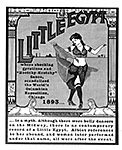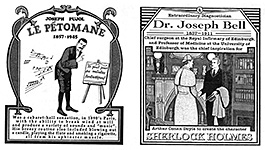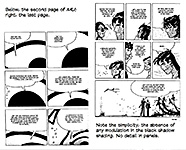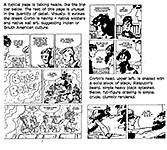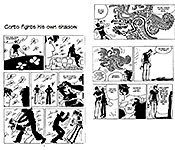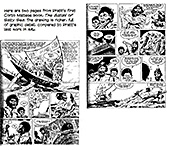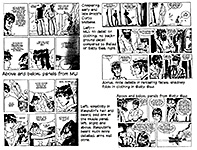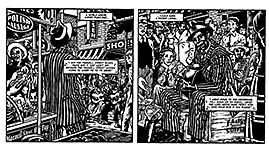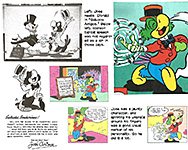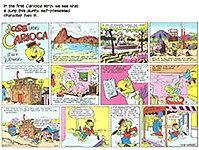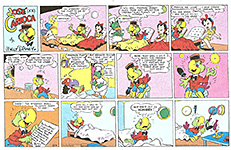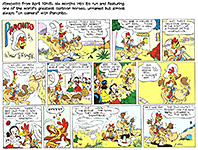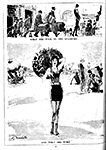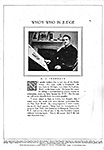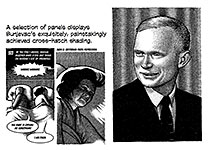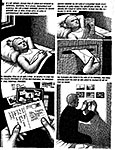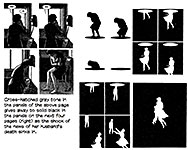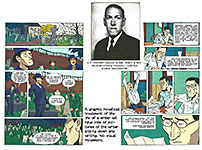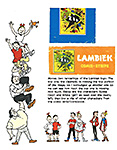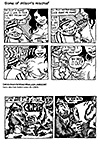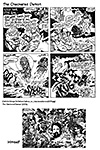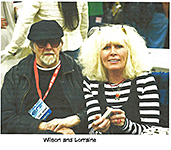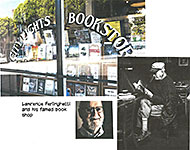 |
|||||||||||||||||||||||||||||
Opus 414 (news through February 28, 2021). Herein a Giant Posting— New Yorker anniversary issue, another Stan Lee biog, RCH’s Stan Lee at Marvel, preserving Peanuts, Bill Chenoweth (Russian), RCH as a Republicon Editoonist, Disney’s Jose Carioca, Corto Maltese Mu Lost Continent, obits for Wilson, Limbaugh, Flynt, Ferlinghetti plus 7 reviews of No.1s and two graphic novels, Fatherland and H.P. Lovecraft —and more, much more. Here’s what’s here, by department, in order (the longest entries are marked with an asterisk* a reader’s guide to help you decide where to spend your time)—:
NOUS R US Comeback Is Greater Than the Setback Image Comics Ends Blanket Returnability Milestone Media Returns Guide to Black Comics Community *Keeping the Faith with Charlie Brown and Charles M. Schlulz Zdarsky Starts at DC with Justice League *Political Clippings from Association of American Editoonists Bully for Edwina Dumm DC Dips Into Movies of Yore **That Time of Year Again: The New Yorker Anniversary Issue With a Review of Another Stan Lee Biography *RCH Version of Stan Lee’s Life with Marvel
FURTHER ADO Trump’s Poll Numbers Drop
FUNNYBOOK FAN FARE Cross Over, Nos.1-3 Miskatonic, Nos.1-3 Scumbag, No.1 Zorro Times Tales (reprints) Bomb Queen, No.4 Black Friday, No.1 Steambound, No.1 Young Hellboy, No.1
*TRUMPERIES The Antics and Idiocies of Our Bloviating Buffoon in Chief —In Prose and Editoons
CRAZIES AND BULLIES *RCH History as a Republicon Editoonist QAnon
*BILL CHENOWETH, ERSTWHILE RCH BOSS Artist, Salesman, Politician, Comedian EDITOONERY A Short Stack of Headline News Editooned
THE FROTH ESTATE The Alleged “News” Institution Tribune Publishing Purchased by Cost-cutting Hedge Fund
NEWSPAPER COMICS PAGE VIGIL Examining The Bump and Grind of Daily Stripping
RANTS & RAVES GALLERY Breakfast with Hearts Factualities
BOOK MARQUEE Short Reviews Of—: Corto Maltese: Mu the Lost Continent Love In Vein: Robert Johnson Life in Graphic Novel Form
BOOK REVIEWS Critiques and Longer Reviews Of—: Walt Disney’s Jose Carioca in Silly Symphonies, Vol.4
BOTTOM LINERS Single Panel Magazine Cartooning A.J. Trembath, 1925-26
LONG FORM PAGINATED CARTOON STRIPS Reviews of Graphic Novels—: *Fatherland: A Family History *H.P. Lovecraft: He Who Wrote in the Darkness
BADINAGE & BAGATELLES Lambiek Comiclopedia Explained
Amanda Gorman’s Inauguration Day Poem
PASSIN’ THROUGH **S. Clay Wilson, 1941-2021 **Rush Limbaugh *Larry Flynt *Lawrence Ferlinghetti
QUOTE OF THE MONTH If Not of A Lifetime “Goddamn it, you’ve got to be kind.”—Kurt Vonnegut Our Motto: It takes all kinds. Live and let live. Wear glasses if you need ’em.
But it’s hard to live by this axiom in the Age of Tea Baggers, so we’ve added another motto: Seven days without comics makes one weak. (You can’t have too many mottos.)
And in the same spirit, here’s—: Chatter matters, so let’s keep talking about comics. AND—
“If we can imagine a better world, then we can make a better world.”
And our customary reminder: don’t forget to activate the “Bathroom Button” by clicking on the “print friendly version” so you can print off a copy of just this installment for reading later, at your leisure while enthroned. Without further adieu, then, here we go—:
NOUS R US Some of All the News That Gives Us Fits
COMEBACK IS GREATER THAN THE SETBACK Marty Grosser, editor of Diamond’s Preview catalog, says, in the February issue—: This past December, the Hollywood Reporter published an article detailing the strength and resiliency of the Comics Industry in the wake of the Covid-19 pandemic. While some stores have been adversely affected by these days of uncertainty, still more stores are reporting stable or even greater sales than were experienced last year—before all this started. It’s a testament to the Comics Industry that our publishers, retailers, and the fans have kept our beloved hobby and livelihood alive and, in some instances, thriving. RCH: It also testifies to the great need most of us have for something to do while locked away from the rest of the world: we read comicbooks, and we evidently read more of them than we usually do.
IMAGE COMICS ENDS BLANKET RETURNABILITY In another sign of the improving times, at ICv2, Milton Griepp reported: In a sign that the comic business is returning to normal, Image Comics is ending its line-wide returnability program, Diamond Comic Distributors told its customers February 9. Image is maintaining its No Risk No.1 program, which offers returns on selected first issues, affecting four issues solicited in January and seven in February. Image was in it for the long haul; it first announced that it would make its line returnable last March, in response to the early days of the Covid crisis.
MILESTONE MEDIA RETURNS Milestone Media, the African American–owned publisher that created the celebrated Black superhero comics universe, will relaunch its publishing program later this month with the release of newly created original comics series in digital and print formats. Cofounded in 1993 by Dwayne McDuffie, Denys Cowan, Michael Davis, and Derek T. Dingle, in partnership with DC Comics, Milestone Media has been reorganized under the direction of the acclaimed director, comics writer and producer Reginald Hudlin, and two of the company's original cofounders: celebrated comics artist Cowan, and Dingle, v-p and editor in chief of Black Enterprise magazine. DC publisher and chief creative officer Jim Lee, said: “Reggie [Hudlin], Denys [Cowan], and our editorial team have been working incredibly hard to bring this new Milestone to life. It’s been exciting to see fresh and contemporary takes on the Dakota universe coming together; I think that both new fans and old will be pleased with the results.” Milestone Media was a landmark event in comics publishing— a Black-owned publisher producing original comics featuring Black superhero characters created by Black comics artists. The Milestone comics universe featured such characters as Static Shock, Hardware, and Icon & Rocket, whose adventures were set in the fictional city of Dakota. After Milestone shut down its comics division in 1997, there have been continual efforts revive the characters. Milestone will officially return on February 23 with the release of Milestone Returns: Infinite No.0, a one-shot 17-page comic release originally offered during DC FanDome that will be updated with 24 pages of new material written by Hudlin and drawn by Cowan, Nikolas Draper-Ivey, Bill Sienkiewicz, and others. The book retells the Milestone universe origin story based around the events of The Big Bang, a police-brutality protest in Dakota City that sparked a wave of superpowers among the city’s Black residents. In April, the popular Static series will be revived with the new adventures of Virgil Hawkins, a teenager gifted with electromagnetic powers. In the new releases, Virgil responds to a clash between a wave of Black teens who discover they have superpowers and a dangerous response from an over-militarized Dakota City police force. Static will launch in a six-issue digital-first series. In June, Milestone will kickoff a new digital-first series starring Icon and Rocket; it’s the story of Icon, a powerful alien trapped on earth who takes the form of Augustus Freeman, an African American man; and his sidekick Rocket, Raquel Ervin, a human teenage girl empowered by Icon’s alien technology.
GUIDE TO BLACK COMICS COMMUNITY The Access Guide to the Black Comic Book Community 2020-2021 is the first in a series of reference works that will introduce creators of color who released books in 2020 as well as industry institutions and events that spotlight their works reports Calvin Reid at publishersweekly.com Released February 17, the reference work’s proceeds will be donated to the Dwayne McDuffie Foundation to be used to subsidize academic scholarships for diverse students. The foundation is named after the late McDuffie, an Eisner-award winning comics writer, animator and a cofounder of Milestone Media. The Access Guide features short profiles of conventions, publishers, and creators. This edition includes 74 books, 39 publishers, and 11 conventions. Planned for annual release in February hereafter, the reference is intended to encourage creators who may not see themselves represented in the industry or in their favorite genres, as well as show new releases, stores, and events where they can be found. Joe Illidge, executive editor of Heavy Metal magazine and a longtime industry activist on diversity in American comics and one of persons responsible for The Guide said: “Black creators and executives have been movers and shakers in the comic book industry for the last fifty years,” Illidge said. “Now that their voices and contributions have become more prominent, it’s our honor to spotlight Black creativity.”
"WE DON'T WANT CHARLIE BROWN WITH A CELL PHONE" And Apple TV+ Will Protect Schulz’s Creation Sitting in an office in Santa Rosa, California, where the museum dedicated to the work of cartoonist Charles M. Schulz is located, his widow, Jean, reviews two of the Snoopy strips that best represent her husband's work, reports Romina Raglianti at digital.elmercurio.com. Both strips are from 1967: in one, the famous dog dances with a leaf that falls from a tree; in another, he skates on ice and performs a double axel. "What is special to me about the skating strip is the authenticity with which he worked his art," Jean Schulz says to El Mercurio through a video call. "He used someone's rotoscope on a skating rink for Snoopy to replicate a skater’s action. In the other, what is striking is that the important thing is not just the joke: it also has to be a well-drawn panel.” It is the interest in maintaining the authenticity of the Peanuts comics that led Schulz’s heirs to partner with Apple. There was interest from other companies, including Pixar, but according to Jean, Apple was the only one that wanted to do a collaborative work. Said she: "We are very grateful that they wanted to work with the family. They worked very hard studying classic animation and comics to make sure everything was correct." As chairman of the board of directors of the Charles M. Schulz Museum, Jean— who was married to the artist from 1973 until his death in 2000— has dedicated herself to preserving his legacy and the integrity of Peanuts.
IN FEBRUARY, THE CHARACTERS RETURNED to the screen at Apple TV+ for the first time in more than a decade of American television in "The Snoopy Show," an animated series that keeps intact the aesthetic and the humor of its creator. In fact, the plots of each episode— containing three stories in each— are straight out of the strip. At a time when most of us crave escape from an eternal Covid-19 present, says Saul Austerlitz at nytimes.com, “The Snoopy Show” takes us into another world, Snoopy’s inner world: all the familiar faces are back, but the show revolves primarily around Snoopy’s lavish fantasy life, which takes him to the bottom of the ocean, to the Wild West and into the skies, where he duels once more with the Red Baron. Said Austerlitz: “The six-episode series is a zippy, brightly colored update of the ‘Peanuts’ specials that were annual presences on fall and winter television schedules for decades (first on CBS, then on ABC). For many of us, they were holiday staples of our childhoods, so much so that it sparked an outcry when Apple announced last fall that the specials would stream exclusively on its platform. More than 260,000 people signed a petition to return them to broadcast TV, and Apple responded with a deal that also allowed PBS to air ‘A Charlie Brown Thanksgiving’ and ‘A Charlie Brown Christmas.’” "Our entire life is dedicated to perpetuating what's in the strip,” Jean Schulz told Raglianti. “We don't want to change, we don't want Charlie Brown to have a cell phone. We want to preserve the humor of 'Sparky' (her husband's nickname), because we believe that it is timeless, and we want to preserve its characters for the future, because three generations have read and enjoyed the comic and we want more generations to do so without change to something that does not belong to my husband.” Despite being around for over 70 years, Snoopy and his friends are still relevant in popular culture, says Raglianti. "The characteristics of each character are unique, but also very human," says Schulz. "Charlie Brown is the always hopeful, but not always successful; Linus is the deep thinker, who thinks too much and gets in trouble for it; Lucy is the one who thinks she knows everything, but also has her fragility, and some believe that Schroeder is Sparky, involved in his drawings and ignoring others, but we all know people who live in their own world. They all represent a part of us.”
ZDARSKY STARTS AT DC WITH JUSTICE LEAGUE Justice League: Last Ride, a new 16-part digital-first series from writer Chip Zdarsky, artist Miguel Mendonça, and colorist Enrica Eren Angiolini, is slated to hit digitally on April 14, reports Zack Quaintance at comicsbeat.com. It will kick off with a story that involves the League breaking up, an unthinkable tragedy, and ultimately a chance for reconciliation amid the backdrop of “the universe’s greatest murder trial.” This marks the first prolonged work for Zdarsky as a writer with DC, having been exclusively with Marvel for some years before starting to dabble with short pieces in DC anthology comics.
Political Clippings & Cartooning Snippets from THE NOTEBOOK ANNUAL 2020 Newsletter of the Association of American Editorial Cartoonists ● The current prez of the National Cartoonists Society, Jason Chatfield, had Covid-19 and has posted a long scrolling autobiographical cartoon detailing his battle with the virus. See jasonchatfield.com/coronavirus ● Bailey Dabney, regional publisher of the Morning News in Florence, S.C., says: “It seems like these days, every comic either hates Trump or hates someone else. If editorial cartoonists get in the habit of lifting people up instead of tearing people apart, then everyone will want them.” To which Notebook editor J.P. Trostle responded: “Dude, that’s called a greeting card.” ● At the CagleCartoons site, syndicate owner Daryl Cagle (who is not alone in this) has registered mild alarm at the considerable number of newspaper editors who don’t want editoons to take stands on controversial issues. They like quiet stuff. (See Opus 406, “Anemic Choices.”) Mike Peterson, who writes about comics afor the Daily Cartoonist blog, is seeing a rise in this sentiment. “I think the idea that there should be a cartoon on the editorial page is well set, but the idea that you should never [tick] off anybody is gaining ground.”
● Editoonist Matt Wuerker: “We have a lot to think about, lots we can improve upon as a country. I welcome the idea editors and cartoonists are taking this moment to be introspective and even awaken themselves to the levels of racism and bias in American society. I don’t see how you can see this as anything but a good thing. That said, there are plenty of people that find this “time of reckoning” an offensive idea, just like they thought [Colin] Kaepernick taking a knee was hugely offensive. ... And they’re saying so in their cartoons. Hey, it’s a free country! The backlash, though, is different this time. In the age of social media, the slap-down of anyone taking an opposing view is itself over the line. Calling for editors to resign and cartoonists to be sacked comes from an unhealthy intolerance. Everyone has a right to be offended by the opinions of others, and they have a right to express that offense. But Twitter mobs out to hunt down the heretics and burn them at the stake (this goes on on both sides) seems out of control and un-American to me. I think the free market of ideas is not just a good idea but it’s an essential part of pluralistic democracy. I love political humor, but for political satire to survive, it needs to operate in this open free market where people have to tolerate opposing views and accept that some of them will be offensive to some people. ... I think it’s wrong-headed to frame this as just a problem of the thought police on the left. The cult of personality around Trump engages in the same thought-policing of its ranks, and I think is likely far emore dangerous. Any criticism of Trump from Republicans is voraciously attacked. Trump can say and do anything, and what we used to call the conservative movement kowtows to all of it. The argument on the left is far more diverse and contentious than the lock-step obedience you find in Magaland. ... I fear that we’re seeing the center not holding. The mainstream media [is] eroding away. The middle ground where you’d encounter diverse conflicting opinion is being replaced by polarized tribalism. ... Instead of shying away from hot topics, I think cartoonists, like many journalists, are choosing which choir they’re going to preach to and catering to those viewpoints. Sadly, we’re losing the ability to have a conversation across the battle lines that have been drawn in our severely divided country.
● Liza Donnelly had an exhibit at the Norman Rockwell Museum in Stockbridge, MA, last summer and was invited to use Rockwell’s studio, the first artist to do so since the painter’s death in 1978. “It was an honor to work lin his studio and brought chills. I sat there as if in a trance, thinking about the painter and wondering about his motivation, his fears, his anger, his joy and frustration for his work. All the same things I feel in my own studio, every day.” ● At about 3 a.m. one day, Mike Luckovich awoke from a sound sleep with this thought: “Biden” sounds like “Bye Don.” “I got so excited I had to go have a drink of wine,” he said. When his wife so a sketch of the idea as a bumper sticker, she said she’d love to have such a bumper sticker. And once the slogan made it on Facebook and Twitter, lots of other people wanted a bumper sticker. So it was arranged. ●
Hereabouts, a couple cartoons culled from the AAEC publication.
Bully for Edwinda Dumm! At his Inkslinger.ink blog, Rob Stolzer has posted a long and lavishly illustrated appreciation of Edwina Dumm and her comic strip Cap Stubbs and Tippie, which may have run almost 50 years (until 1966) in the nation’s newspapers. After referring us to the Dumm biographical information at the Billy Ireland Cartoon Library and Museum at Ohio State University— cartoons.osu.edu/digital_exhibits/edwinadumm/biography.html —Stolzer goes on to discuss in great detail the two Tippies in the strip, one a bulldog, the other a terrier. (Ahh—you didn’t know there’d been two?) The posting also includes a purely wonderful photograph of British cartoonist Phil May. Go there and see.
DC DIPS INTO MOVIES OF YORE From ICv2—: DC Comics will release comic series set in the worlds of the 1989 Tim Burton Batman movie and the 1978 Richard Donner Superman movie beginning in August, with hardcovers to follow. Sam Hamm, who wrote the screenplay for Burton’s 1989 take on Batman starring Michael Keaton, will team with artist Joe Quinones on a new story that will help usher in the return of Catwoman and debut a new Robin. Quinones also shares a new vision for Harvey Dent/Two-Face. The six-issue Batman 89 comic series, launching in August, will be followed by a hardcover in October. Superman 78, written by Rob Venditti with art by Wilfredo Torres, is set in the world of the film starring Christopher Reeves, in which Superman has just been introduced and bystanders are excited about seeing him for the first time. The film was a landmark in the depiction of superheroes. The six -issue Superman 78 comic series, launching in August, will be followed by a hardcover in November.
THAT TIME OF YEAR AGAIN At the end of
February every year, we look forward to seeing what havoc the editors at The
New Yorker have wrought on the cover of the magazine’s anniversary issue.
The cover of the first issue of The NewYorker, February 21, 1925,
carried an oddly inappropriate drawing by Rea Irvin that depicted a Beau
Brummell-like dandy in top hat and high stock, a supercilious boulevardier
inspecting a butterfly through his monocle—scarcely what you would expect to
find on the cover of a brand new, sophisticated 20th century humor
magazine.
Since then, although the Irvin drawing re-appears occasionally for the anniversary issue, the tradition is broken as often as it is kept. (As you’ll discover at Opus 156.) This year, the damage is done by Sergio Garcia Sanchez. The New Yorker’s art editor Francoise Mouly explains—: “For The New Yorker’s ninety-sixth anniversary, Sergio García Sánchez draws
the magazine’s trademark dandy, Eustace Tilley, masked and with a vaccine dose
in hand. We also see scenes of pandemic life, and the contours of a city
waiting to reëmerge. ‘With masks, social distancing, and vaccines, we’ll slowly
recover life in the city,’ Sánchez told us. ‘The chance encounters with people
of all cultures; the thrill of eating outside at any hour. The city is a
container for so many stories, and soon they’ll be out in the open again.’” In just four short years, we’ll have the dubious pleasure of seeing what The New Yorker editors’ll conjure up for the 100th anniversary issue. Something centennial, no doubt. Imagine Eustace Tilley surrounded by 100 butterflies. (H’mmm. Maybe I’ll drop Mouly a note.) For more on the covers topic, visit https://www.newyorker.com/culture/cover-story/cover-story-2021-02-15 And for the entire history and biography of Eustace Tilley, who he is and why, visit Harv’s Hindsight for March 2015. Meanwhile, we have the other picture on our visual aid of this year’s anniversary cover—a full-page picture of Marvel Comics’ Stan Lee, who is the subject of an article in the anniversary issue, a review of another in the seemingly unending parade of Stan Lee biographies; this one, True Believer by Abraham Riesman. Just for a few derisive laughs, I’ve attached my caricature of Stan Lee, adorning one of those “blank” covers, this one for Marvel Comics #1000. Finished art and rough sketches.
ANOTHER Stan Lee Biography. Riesman’s contribution to the cottage industry of Stan Lee biographies takes the position that Lee isn’t what he appears to be, an appearance Riesman apparently believes that Lee carefully orchestrated in a continuous effort at self-promotion and -aggrandizement (but which I, having more experience at Stan Lee than Riesman, believe to be merely the result of various accidents, which we’ll go into at a future opus). The review of Riesman’s book is conducted by Stephanie Burt, otherwise an English professor at Harvard, who, judging from her review, is apparently anxious to prove she is with-it on comicbooks. But she stumbles occasionally. She says Riesman’s book (Crown 2021) is “the first biography completed since Lee’s death in 2018,” overlooking at least two others, both completed since Stan Lee died: Danny Fingeroth’s A Marvelous Life was published in 2019; and Liel Leibovitz’s Stan Lee: A Life in Comics, published in 2020. Lee went to work in his uncle’s comicbook company; yes, but Goodman’s publishing company produced other publications as well—pulps, as they were known, among them, Ka-Zar (a Tarzan knock-off) and Marvel Science Stories, and a title or two aimed at male readers. She says Jack Kirby was known for drawing “dynamic action and far-out costumes”; yes to the first, but probably not the second. Eager (it seems) to show off her esoteric college-bred knowledge, she drops a couple unlikely foreign terms: kunstlerroman and stakhanovite. The first, in reference to Lee’s life working in an art form, is supposed to remind us of a story in which the hero often dreams of becoming a great artist but settles for being a merely useful citizen. The künstlerroman often ends on a note of arrogant rejection of the commonplace life. With stakhanovite, she refers to Jack Kirby’s extremely productive life/work style, which, the term suggests, is akin that of a Soviet industrial worker awarded recognition and special privileges for output beyond production norms. I must point out that I haven’t read Riesman’s tome yet, so my only knowledge of it comes from reading Burt’s review. And it’s difficult to tell, much of the time, whether Burt is repeating Riesman’s opinions or asserting her own in imitation of Riesman. She is immediately hostile to Lee the creator of the Marvel universe. She begins at once belittling Lee’s achievement, suggesting strenuously that his achievement is a fiction about his prowess that was created entirely by Stan Lee. Lee, Burt insists, was “a grand self-mythologizer ... He became the face of the company. No one could stop him.” And she refers more than once to Lee’s apparent need for attention. The talentless Lee couldn’t do much by himself, Burt says. But she acknowledges his skill at orchestrating the production of Goodman’s comicbook company, failing to recognize that orchestration is a talent. And Lee did that by himself, giving orders to others. She quotes Chris Claremont (who, I assume, is quoted by Riesman), who “recalls a figure [Lee] ‘good as an editor, equally good as a manager, equally good as inspiration.’ Artists and writers whom Lee would have regarded as his juniors generally paint him in the sixties as bombastic but kind, reliable, fun to work with.” So Lee isn’t all self-aggrandizement. In her closing remarks, Burt backs off the posture she’s assumed for most of the article. She’s no longer hostile to Stan Lee: “The mutant nation [X-men but also, I’d say—speaking poetically— the entire roster of Marvel superheroes] could never have been created—or even anticipated—by the fast-talking, smug, sometimes generous, and surprisingly conventional Lee. But it could never have happened without him.” I’ve ordered the book, so I’ll soon see the real Riesman. Meanwhile, I’ll use the rest of the space I’ve allotted to this subject to regale you with my version of Stan Lee’s life with Marvel.
RCH’s Version of Stan Lee at Marvel Comics AS I’VE SAID BEFORE, in creating the Fantastic Four in November 1961, Stan Lee did not set out to invent a team of superheroes that quarreled and bickered amongst themselves. He set out to concoct a parody of superheroes. He was trying to ridicule them. Until now, he hasn’t got away with it: nobody knew the Fantastic Four was a parody because Stan Lee was not a very good writer. For years, he wrote slapstick comedy, making humor by punning, as we’ve seen with My Friend Irma and other “babe books” in the Opus 413. Corny stuff, and Stan was adept at corny. But serious comedy—parody—exceeded his ability. So the Fantastic Four wound up looking like a fresh, new kind of superheroes. The usual story of the creation of the Fantastic Four involves Stan’s wife, Joan. According to the treasured litany, Stan was complaining to Joan about his latest assignment from Martin Goodman—to create a team of superheroes like the one just recently launched at DC Comics, the Justice League. Stan was complaining because (as Danny Fingeroth has it) “he didn’t want to just revive the old Timely heroes.” At this point, Joan interrupts him and tells him “(as she seems to have told him numerous times in an ongoing conversation) that he might as well try to do something different—quit complaining about being forced to churn out formulaic pap— and see what would develop. The worst that could happen is that Martin would fire him ... and he’d been claiming to want to quit anyway.” So, disliking superheroes and the formulaic pap they wallowed in, Lee decided he’d just ridicule superheroes by showing them to be flawed human beings despite their super powers. He’d write a parody. And he did. And when readers responded to the “parody” be applauding this “fresh, new” approach—superheroes with normal, human failings—not recognizing it as parody, Stan was surprised. But he was promoter enough to recognize good thing when he saw it: he went on playing to that appreciative audience, only now he wasn’t trying to write parody. He just produced more episodes in which the Fantastic Four interrupted superheroing every so often to quibble amongst themselves. If readers liked superheroes for their superhuman strength, then he’d give them unadulterated strength with the Hulk in the spring of 1962. If readers liked superheroes with feet of clay, then perhaps they’d like a teenage superhero plagued by all the usual adolescent problems of insecurity and self-doubt. So Stan created Spider-Man in the summer of 1962. By now, Stan was on a roll. He’d long ago given up parody. He was writing superheroes with ordinary human personalities. And comicbooks about these kinds of characters were attracting the attention of the mainstream news media. And that’s where Stan stumbled. According to Riesman (as recounted by Burt), Nat Freedland, a reporter for the New York Herald Tribune, came to the Marvel office in search of a story about these “new” superheroes. And Stan gave him a story. He demonstrated the “Marvel Method” of producing comicbook stories. Stan had been forced to develop the Marvel Method by the quantity of comicbooks he was committed to writing. He simply didn’t have time to produce full scripts with dialogue and stage directions in the customary manner of a movie script. So he short-cutted. He’d meet with the artist assigned to a book, and he’d suggest a topic or a storyline, discussing it briefly with the artist, both of them adding turns and twists to the story as they talked. Then the artist would go off and draw the story, often adding new twists and ramifications as he drew. Then he’d give Stan the pencilled pages, and Stan would write captions and speeches that carried the storyline, adding quips and quirks as he went. When Freedland wrote about Stan’s demonstration of the Marvel Method, he focused on Stan’s role in the “writing” of the stories. Freedland was a writer, of course, and he understood writing; he didn’t understand drawing, so his report didn’t say much about that. As a result, Stan emerged as the creative powerhouse at Marvel Comics. He was the star of the show.
NOW, I DOUBT THAT STAN KNEW what would be the consequences of his demonstration of the Marvel Method. He didn’t deliberately set out to portray himself as the heart and soul, the main creative force of Marvel Comics. He didn’t deliberately leave his artist collaborators out of the process. He was just giving Freedland a story—a somewhat sensational story about how he and his artists created comic books, a story that would promote Marvel Comics. And comics in general. Until the arrival of the Marvel universe of flawed superheroes, comicbooks were largely ignored by the general public—if they were not also disdained. Publicity like Freedland would produce—and that others following in his footsteps would produce—would go far towards redeeming comics as an entertainment art form. That was the over-all purpose of the demonstration of the Marvel Method. But the demonstration had the incidental effect of portraying Stan as the initiating creative force in making Marvel Comics. After that, he was suddenly the “face” of Marvel Comics. And he was approached by other reporters, whose reports kept repeating Stan’s role in the process until the artists didn’t seem to be contributing much to the process. Some of the artists who had descended into anonymity in the public prints began to feel snubbed by their editor/boss. When they started to object, Stan suddenly realized what was happening, and he tried to re-insert artists into the process, naming them when talking to reporters. By then, alas, the mold was set: Stan was the man. He was the story. But fans began to sound off, labeling Lee as an ego-centric show-off who could care less for the careers and fates of the artists he worked with. And there was the example of Steve Ditko quitting (in a huff? everyone wanted to find out). And when Kirby quit, what was that about? More fed up with Stan’s self-promotion? All of this prompted fans to do more careful research into the relationship between Lee and the artists. Careful examination showed that Lee was the victim of accidental advancement rather than the instigator of conscious plotting. But it was too late. In writing his book, Abraham Riesman set out to correct the record, to expose Stan Lee as a fake. He was not the sole creative force at Marvel. As I said, I haven’t read Riesman yet, but I suspect he doesn’t recognize Stan Lee’s rise as largely an accident. Instead (judging from Burt’s review), Riesman sees Stan Lee’s machinations as a deliberate attempt to get the spotlight to shine on him and him alone with Stan making a conscious attempt at self-glorification. Although much of the publicity surrounding the publication of True Believer claims that Riesman’s treatment of Stan Lee’s professional personality is an expose of huge dimensions, it actually isn’t. Stan Lee has been unmasked by others repeatedly over the last 20-30 years. So there may not be anything new and/or earth-shaking in Riesman’s book, despite the assertions of the publicity department. We’ll soon find out. Just as I was typing the foregoing, the mail arrived, and it included a copy of Riesman’s True Believer. We’re not supposed to judge a book by its cover, but if we compare Riesman’s cover to Fingeroth’s, what a difference: one cheerful and jocular; the other, grim as death. Stay ’tooned.
The
book has quite a large photograph section. And one of the photos shows Stan Lee
at a table autographing books/magazines. A kid is standing in front of Lee,
watching him. The caption reads: “The author For lengthy discussions about who did what at Marvel—Lee or Kirby—visit Harv’s Hindsight for April 2008 (“What Jack Kirby Did”) and for July 2003 (“Making the Marvel Universe”).
ODDS & ADDENDA We don’t usually review motion pictures in any of their varying forms, but we watched the new tv show, “Superman and Lois,” the other night. Not bad. Clark Kent and Lois Lane are married in this enterprise, and they have two teenage sons. Trouble. Lois (played by a no-nonsense Elizabeth Tulloch) seems to wear the pants in the family: Clark just bumbles along, taking her advice whenever she offers it. And we wish she’d taken a stand against show’s producers letting Clark and Superman have beard stubble. Okay: that’s the present male fashion, but some people’s stubble looks better than others’, and actor Tyler Hoechlin’s is a little too shabby-looking for our taste.
Fascinating Footnit. Much of the news retailed in the foregoing segment is culled from articles indexed at https://www.facebook.com/comicsresearchbibliography/, and eventually compiled into the Comics Research Bibliography, by Michael Rhode, who covers comic books, comic strips, animation, caricature, cartoons, bandes dessinees and related topics. It also provides links to numerous other sites that delve deeply into cartooning topics. For even more comics news, consult these three other sites: Mark Evanier’s povonline.com, Alan Gardner’s DailyCartoonist.com (now operated without Gardner by AndrewsMcMeel, D.D. Degg, editor); and Michael Cavna at voices.washingtonpost.com./comic-riffs . For delving into the history of our beloved medium, you can’t go wrong by visiting Allan Holtz’s strippersguide.blogspot.com, where Allan regularly posts rare findings from his forays into the vast reaches of newspaper microfilm files hither and yon.
FURTHER ADO A Change in the Polling of the Trumpet By David Leonhardt at nytimes.com During the long debate over Donald Trump’s first impeachment, the share of Americans who favored removing him from office never rose above 50 percent. It hovered in a tight range around 47 percent, according to FiveThirtyEight’s polling average. Trump’s second impeachment is different: Most Americans believe the Senate should convict Trump and disqualify him from holding office again, according to multiple polls. In a recent CBS News poll taken when the second impeachment was pending, 56 percent of respondents said they supported conviction. In an ABC/Ipsos poll, 56 percent said he should be convicted and barred from office. Gallup found people favoring conviction by a margin of 52 percent to 45 percent — which is close to the average of all recent polls. In our deeply polarized country, even a narrow majority of public opinion is significant. It indicates that a meaningful number of people have crossed over to the other side of a debate. In the CBS poll, for example, 21 percent of Republican voters said they believed Trump had encouraged violence during the January 6 attack on the Capitol. (A new Times video lays out the many lies he told about the election, feeding the crowd’s anger.) RCH: Of course, polling results change by the day, by the hour. By the time you read this, Trump will be on top again. Who knows?
AntiVax Poll And while we’re on the subject of polls, here’s one that bodes well for the future of the country. According to a small poll conducted in these parts, 88% of Democrants polled said they planned to get a Covid-19 vaccination; only 29% of Republicons did. The low turn-out of Republicons is no doubt due to the high number of Q-people in their ranks. And the Q-people believe that the vaccines are bad for you. Whichever arm you take your shot in will become paralyzed and remain so until you get the second shot—or you die, whichever comes first (and most of the Q-people believe the latter rather than the former). In the short run, this is terrible news. Assuming that Republicons account for about 30% of the population, most of those (88% like I said) aren’t going to get shot. That will make the goal of herd immunity difficult to attain. As a result, more of us will die. In the long run, since the percentage of Republicons refusing the shot is higher than the number of Democrants, this ludicrous posture of the Q-infected Republicons will result in their ranks thinning considerably. They’ll die off in larger numbers than the Democrants. Already the minority party, the Grandstanding Obstructionist Pachyderm will become even moreso. And perhaps, as a result, the Republicon Party must begin to act like a minority party instead of like a monarch over all of us. Then life will improve.
WIT & WISDOM The only difference between death and taxes is that death doesn’t get worse every time Congress meets.—Will Rogers Poetry is news from the frontiers of consciousness.—Lawrence Ferlnghetti
FUNNYBOOK FAN FARE Four-color Frolics An admirable first issue must, above all else, contain such matter as will compel a reader to buy the second issue. At the same time, while provoking curiosity through mysteriousness, a good first issue must avoid being so mysterious as to be cryptic or incomprehensible. And, thirdly, it should introduce the title’s principals, preferably in a way that makes us care about them. Fourth, a first issue should include a complete “episode”—that is, something should happen, a crisis of some kind, which is resolved by the end of the issue, without, at the same time, detracting from the cliffhanger aspect of the effort that will compel us to buy the next issue. A completed episode displays decisive action or attitude, telling us that the book’s creators can manage their medium.
I’M ENJOYING THE HELL out of Cross Over. So far, I’m through No.3, and I still can’t tell you exactly what “cross over” means. But Geoff Shaw’s artwork is purely stunning, and I’d read anything just to see how he draws it. The over-view, which I’m piecing together from all three issues, is that the world of superheroes collided with our world. And there was an “event” on January 11, 2017 that involved lots of superheroes fighting or flying around Denver, Colorado. After which, Colorado was isolated by erecting a force field—the Dome?—around it, to protect those inside the Dome from everyone else because those inside the Dome (the superheroes?) are despised (?) by the rest of the population? The first issue opens with an essay in captions that establishes that Superman and his ilk are “permanent”; and we are not. Maybe that’s why they are hated. Next, we meet a masked woman, Ellipses Howell; Ellie. Her mask is part of her cosplay. She works (and, secretly, lives inside) a comics shop run by Otto. Otto doesn’t buy “old” comicbooks. He deals only in government-approved and mandated corporate comics. “Marvel and DC died when Colorado died,” he remarks. And their books are apparently verboten. They
see a kid swiping a comic, and when they confront her, they see her face/skin
(and all her clothing) is dotted. That’s the way old comicbooks made flesh
color: they put red dots on solid yellow, and it turned faces flesh color. She
is, they say, “a fake.” One of “the comicbook folks.” Her name is Ava Quinn;
she’s maybe 12 years old. People run away because it’s sinful to associate with one of “them.” She’s not supposed to be “out of the bubble”—the Dome. Ellie’s parents are in the bubble, too; like Ava’s. Then we meet Ryan Lowe, son of fake minister/priest, who upsets father by having a comicbook. He joins the mob outside Otto’s shop and throws a bomb through a window. It explodes and destroys the shop. Captions say this is a story about believing in something when the whole world tells you that you’re wrong... about trying to find a home when yours in Brooklyn is gone. “This is a story about HOPE.” That ends No.1. It’s full of completed episodes, proving that writer Donny Cates and Shaw can handle a storyline that shifts rapidly from event to event. Each episode tells us more about our principals—Ellie, Otto, Ava, and Ryan. But the situation in which they find themselves is only hinted at in the narrative. The Dome as a haven for Superheroes? Or us. Two “worlds.” What, exactly, was “the Event”? None of this is explicitly explained. Allusions but no explanations. “Cross Over”? From one world to the other? Not explained yet. And it’s the title of the book. Normally, this much unexplained mystery would defeat the book. We read on, though, because the personalities of the principles are well-developed enough—and developing as we read—that they carry this fragmented story along.
IN CROSS OVER ISSUE NO.2, Ellie and Ryan meet, and when she realizes that he’s the one who threw the bomb that destroyed her comics shop “home,’ she spits in his face (and an accompanying caption tells us “these two will fall in love”). Ryan is arrested and taken to meet Nathaniel Abrams Pendleton—director of all things related to the Event, who runs various research and development testing facilities around the country—with superheroes as the tested. All cells are equipped with “draining lamps” that drain superheroes of their powers. EXCEPT one; the draining lamps don’t work on him. Pendleton assigns Ryan to go to the Dome, where the undrained superhero is, and shoot him with a special bullet. Meanwhile, Ellie tells Otto they should get into the Dome to return Ava to her parents— and maybe Ellie will find hers. But Ava, we learn, was never in the Dome. She got split away from her parents and subsequently “rescued.” She had been headed for “the camps,” where residents are experimented on. Some may be supers; most are not. Ava’s parents are in one of the camps. While Ellie and Otto discuss Ellie’s plan to return Ava—somewhere?— Ava, left by herself on the porch, sees a rat and roasts it with her eyes; that’s her superpower. Ooops. In issue No.3, Ellie paints Ava’s face to cover up the red dots. Ryan’s father beats him to get him to tell what he told the Feds while arrested; he told them nothing. So he runs away from home, taking Pendleton’s magic pistol with him.
Still, this book is runaway nonsense with new dollops on every page. Nothing carrying us forward except the personalities of the characters. And the brilliance of Shaw’s muscular brushwork. But I’ll be back.
I’M UP TO THE THIRD ISSUE of Miskatonic, too, a story set in the 1920s. In the first issue, we meet our principles: Miranda Keller, an FBI agent, and Tom Malone, a retired NYPD officer. The first page of the book is devoted to panels showing a man who is, by the end of the page, blown up by a bomb. On the next page, we meet Miranda, who, in a discussion with Edgar Hoover, demonstrates her feminist chops, insisting that he call her “Agent Keller” rather than “Ms. Keller.” The book serves up a healthy dose of such feminist aggressiveness as we go along. Miranda inveigles Hoover into assigning her to a case rather than to the secretarial pool, which is his first impulse. She is sent to Miskatonic Valley to investigate a series of bombings that are killing the elite among the citizenry. Once in Miskatonic, she’s convinced that local radicals are to blame. But when they learn that the remains of one bombing victim consists of fish parts and frog parts, Miranda’s partner, Tom, thinks they’re facing a supernatural event like one in his past that left him scarred and scared. That night in her hotel room, Miranda is awakened by mysterious noises, and when she and Tom leave the hotel in the middle of the night, they see crowd of Ku Klux Klanners in the street. Closer to them, Miranda sees they are man-sized reptilian creatures. She confronts them with her pistol, but they charge her, impervious to the bullets she fires. And that’s where writer Mark Sable ends the first issue’s action. But he tacks on a faux letter from FBI’s Clyde Tolson who discusses the case, its strange occurrences, deaths, disappearances and the like. Apart from adding detail to the tale, the letter serves no purpose. Giorgio
Pontrelli drawing style deploys a delicate outline technique, naked,
without any shading. His attention to the detail of locale and background is
meticulous, but his rendering of figures and faces is simple. His lines in
close-ups are surprisingly ragged rather than clipped and clean. Sable’s handling of several episodes demonstrates his skill at storytelling with Pontrelli. They shift camera angle and distance for dramatic emphasis, and pace a suspenseful sequence with close-ups of Miranda at night. The second issue opens with Miranda and Tom successfully fleeing the fish-folk. Then they go to a nearby university to get translated a cryptic note they found at a crime scene. They meet Professor Armitage, a specialist in such matters. They also attend a party given by Asenath Waite, the daughter of one of the victims, who they’d interviewed earlier in the day. During the party, Miranda and Asenath kiss. Then a bomb explodes. Investigating, Tom sees Armitage bending over a disemboweled body, the entrails of which appear to be tentacles. In the third issue, Tom starts referring various people to the local police for arrest. Miranda interviews the arrested Armitage in connection with the deaths of Wilbur Whateley and her father, Ephraim Waite. When she investigates Whateley’s remains, she sees that they are nothing but green liquids.
End of No.3. Again, it’s the characters and their interplay that carries our attention. Otherwise, the story is investigating the supernatural crimes and going nowhere except to introduce new, frightening phenomenon. And the delicacy of Pontrelli’s rendering sustains our interest. Again, I’ll be back for No.4.
AS FOR THE REST
OF MY MONTH’S READING, we’ll skim over the tops. Scumbag No.1, an
attractively named book, is about a scumbag named Ernie Ray Clementine, who is
in hot pursuit of sex. Roland Boschi provides plenty of pictures of
barenekkidwimmin for Ernie to fondle and copulate with. And this goes on for
several pages until we meet corporate powers who offer Ernie a deal: they’ll
give him his own island, stocked with an endless supply of drugs, party girls,
a private jet ... if he’ll report to them whatever his centrist pig masters are
doing. What writer Rick Remender is going to do with this is anybody’s
guess—given how far he’s pushed the envelope so far. In Zorro: Timeless Tales No.1, we have reprints of museum-quality art by Carlo
Marcello and stories by Jean-Marie Nadaud. I just looked at and
liked the pictures, but American Mythology Productions has more Zorro en route. The current issue of Bomb Queen, the fourth, is about the Queen’s sexual encounter with the Prez, Trump, his caricatured self. “I just wanted to fuck the President,” she says, as she slips into panties after the fact, “—check it off my list,” she says, reminding us of Stormy Daniels. They
also have a debate during what appears to be a Presidential campaign. Which she
wins. And she also wins the Election; the Trumpet loses. But all that turns out
to be just a dream (cheap storytelling gimmick), and on the last page, writer/artist Jimmie Robinson reports the election of Joe Biden and Kamala Harris.
Robinson’s clean-lined pictures are a pleasure to watch—particularly when they
are depicting a barenekkidwoman (i.e., the Bomb Queen). And that seems to be the most of what Robinson is up to here. He’s just having fun with Donald J. Trump’s reputation for sexual conquests. Elsewhere, Travis Williamson’s quirky frazzled-line drawing style dominates Black
Friday No.1, which takes place in a department store on the Friday after
Thanksgiving. It’s a mob scene. Javier and his cohorts, Ceci and their
supervisor Alan, discover a huge hoard of dead bodies under the floor. By the
end of the book, writer Jon Clark has the hoard breaking out of their
“prison.” Looks to me like just another of those supernatural spook books, of
which there are too many. And they’re too easy to do: nothing needs to make
sense; everything is possible. Steambound No.1 is another in this trend. Produced by Giuseppe Andreozzi, Lorenzo Di Santo, and Francesca Cittarelli (without telling us who does what), the book’s pictorial content is overwhelming—heavy black outlines and fine-lined interior detail. But some pages are so darkly colored that the pictures are hard to see. And the story is hard to follow. Yaeger and Hound are sometimes teenagers; sometimes grown-ups. Yaeger grows up with a small monster companion, Puk. Conversations refer to people and events we haven’t yet seen and so don’t make sense. And because we see the principle characters as sometimes juveniles and sometimes adults, we can’t get to know either of them. This one fails all the tests for a first issue. Young Hellboy No.1 (of 4), however, does not. With story by Hellboy creator Mike Mignola and Thomas Sniegoski, the book works just fine. Young Hellboy, horns still intact, is en route to a South American locale with Professor Bruttenholm when a fellow passenger (who turns out to be a crazed religious nut) kills the pilots. The plane crashes into the sea, and Hellboy and the Prof get the inflatable raft. The crazed nut surfaces and tries to kill them but is assaulted by giant crabs, foiling his attempt. Meanwhile, a giant ape attacks the raft and upsets it. The
Prof and Hellboy swim to a nearby island inhabited by a flock of mad monkeys,
who, naturally, attack. Next, they’re attacked by hostile giant lizards.
Hellboy falls into quicksand but is rescued by Jungle Girl, one of Young
Hellboy’s heroes. They wander off together into the island jungle, but the last
page of the book is given to the religious nut, who survived the attacks in the
sea and seems to be controlled by an unseen being. The
lizard attack that ends with Hellboy up to his nose in quicksand is one of
several hazardous episodes that And that’s enough for this month. I still have a stack of unread comicbooks on my desk. Maybe next time. ...
REMEMBER WHERE YOU READ THIS What is useful about having a handful of fingers of differing lengths? Why aren’t the fingers all the same length? Is there something we do that we do better because we have one finger at the end of the line that is smaller than all the rest? Does that make picking our noses easier to do? C’mon—there’s gotta be a reason for this. What is it?
TRUMPERIES The Antics and Idiocies of Our Bloviating Buffoon in Chief EXCITEMENT WITHOUT EQUAL. Now that the Trumpet’s second impeachment trial is over without consequence, we have a few minutes to take deep breaths and ponder what’s been happening. First, I’d like to debunk the prevailing notion that the Trump Rioters, in assaulting the Capitol, nearly destroyed our democracy. And that the Trumpet’s insistence that he’d won the election he actually lost—his refusal to concede—likewise threatened our democracy. These events actually did quite the opposite: they affirmed the vitality and resilience of our democracy. Everything worked, just as it was supposed to. The Rioters, who broke laws by destroying government property (at the least), are being arrested as they are being identified. Those who are arrested will be tried. That’s what’s supposed to happen in our democracy. The Trumpet’s refusal to concede amounts to nothing. Just as it should in our democracy. And the fate of the so-called Trump Reign likewise proves our democracy healthy and strong. Most of Trump’s more controversial Executive Orders were contested in court by various bodies. Most of these Trumperies were subsequently thrown out. The legal system works. Yes, there were some ugly moments. There were some moments that doom-sayers could point to as threatening. But our democracy survived, and everything worked, just as the Founders intended. Democracies have ugly moments. That’s the way they are. As Winston Churchill said (in the House of Commons in 1947): “Many forms of Government have been tried, and will be tried in this world of sin and woe. No one pretends that democracy is perfect or all-wise. Indeed it has been said that democracy is the worst form of Government except for all those other forms that have been tried from time to time.…” Democracy is not efficient. The most efficient form of government is a dictatorship. Give me the inefficiency of democracy every time.
THE TRUMPET WAS NOT CONVICTED in the Senate trial. But that is not to say that he’s innocent. He is most assuredly guilty. He’s guilty of inciting a Riot. What he incited was not an insurrection, a formal even if disorderly uprising against a sitting government. It was a Riot. It had no organization, no announced complaint, no articulated objective. It was domestic terrorism, pure and simple. It was an outburst of destructive lawlessness. A Riot of domestic terrorism. Nothing more.
THE TRUMPET MAY NOT have been convicted in the Constitutional sense, which requires a two-thirds vote for conviction. But the vote —57 for conviction, 43 against—was a clear bipartisan majority, something hard to come by in these times.
THE REPUBLICONS PERSISTED in saying that Trump’s speech at the Elipse on January 6 did not cause the riot. It was just harmless political flatulence, unconnected to what followed—that Riot. But Kevin McCarthy’s actions on January 6th betray the actual Republicon position on the matter. As the Riot proceeded in the Capitol, McCarthy phoned Trump and pleaded with him to call off the Rioters. What ensued then was the now famous exchange that began with the Prez repeating the falsehood that it was antifa that had breached the Capitol. McCarthy refused to accept that (as he should). Then the Trumpet said, “Well, Kevin, I guess these people are more upset about the election than you are.” To which McCarthy blurted out, “Who the fuck do you think you’re talking to?” That was followed by what some termed a shouting match. But it started when McCarthy begged Trump to call off the Rioters. In other words, McCarthy—the Minority Leader in the House of Representatives— knew who was in charge of the Riot. The guy who could call it off was the guy who started it. The Trumpet.
ON MONDAY, March 1, the day after the Trumpet’s speech at the annual Conservative Political Action Conference, the Denver Post carried a story about his speech on page 11. Not the front page. Page 11, the next-to-the-last page in the front section of the paper. Trump has definitely fallen from power. He’s no longer front page news. But at CPAC, he’s still the biggest balloon they’ve got. The Associated Press’s Jill Colvin reports: Trump called for GOP unity, even as he exacerbated intraparty divisions by attacking fellow Republicons. ... [Speakers] in panel after panel [repeated] his unfounded claims that he lost re-election only because of mass voter fraud, even though such claims have been rejected by judges, Republicon state officials and Trump’s own administration. ... The Conference’s annual unscientific straw poll of just more than 1,000 attendees found that 97% approved of the job Trump did as president. But they were more ambiguous when asked whether he should run again with only 68% saying he should. If the 2024 primary were held today and Trump were in the race, 55% said they would vote for him.
A SHORT SELECTION of visual Trumperies concludes this portion of Opus 414. “Trumperies” is the name I’ve given to editoons that reveal the Trumpet’s personality more than anything else. Sometimes a Trumpery ’toon shows us how Trump sees himself; sometimes, how others see him. And in our short gallery at hand, we find both. Drew
Sheneman’s image has the Trumpet setting and abetting a fire to destroy the
U.S. Capitol while, at the same time, applying “business” logic, wondering if
he can collect the insurance on the fire he himself has set. It is this logic
which has apparently governed many of the Trumpet’s decisions as Prez: if it
benefits the businessman Trump, then it’s good government policy. Next around the clock, Bill Bramhall deploys a visual metaphor the significance of which is revealed in a pun. And we must look carefully at John Darkow’s drawing to understand what the Secret Service guy means: the Trumpet is flipping us the bird. Then Scott Stantis’ picture shows the danger in acting upon the advice “how much harm could he cause?” And that’ll do it for Trumperies this time. We’ll doubtless have fewer and fewer of them now that the Trumpet has retired to the golf course and various courtrooms where he’ll be tried for an assortment of crimes. For editoons on other topics (but not exclusively), we scroll down to Editoonery. But not before an educational detour that takes us back to my own misguided youth and a short stint on the party newspaper. Which party? you ask. Read on.
QUOTES & MOTS A bird in the hand is safer than one overhead. Never insult an alligator until after you’ve crossed the river. Men marry women in the hope they won’t change. Women marry men in the hope they will change. Both are doomed to disappointment.
CRAZIES AND BULLIES A few centuries ago—when you and I were young, kimo sabe, and the nights were filled with revelry and life was but a song—back then, I was, believe it or don’t, a Republicon. When I was in high school, I worked at a printing shop, and one of the owners was a noted GOP politician in Colorado. (I’ve posted an anecdotal appreciation of Bill Chenoweth down the scroll.) He got me published in The Trumpet, the state Republicon newspaper, which was at the time in its first year of publication, and eager, presumably—there’s no other explanation—to have a editorial cartoonist even if he was just a teenager. Here are a few of my editoons, all from the Election Year 1956.
The caricatures aren’t bad. Except Adlai Stevenson’s. He ran against Dwight Eisenhower (“I Like Ike”) in both 1952 and 1956, and my picture of him is almost a portrait. Harry Truman had been elected to the office only once: he inherited the White House when FDR died in the spring of 1945, and he’d been elected on his own merit in 1948. So he could conceivably run again in 1956 for a second term. The editoon shows him fishing the Press (as news media was called in those antique times) for opinions on the question. Truman’s visage was so widely circulated that caricaturing him was no task at all. Eisenhower was something else again. The most distinctive things about him were his baldness and his broad smile. But a picture of a broadly smiling bald man wouldn’t get Ike. In trying to come up with something, I made a discovery that has informed my caricaturing ever since: every one of Ike’s facial expressions was different and so each expression needed a separate caricature. Anyhow, the caricature of him here is pretty good. One
of my Trumpet cartoons caricatured the Colorado governor at the time, “Big
Ed” Johnson, who wrote to me expressing his appreciation and his fondness
for editorial cartoonists. I suspect that someone must’ve told him the
cartoonist was a teenager who therefore deserved an encouraging response from
him. I remained a stalwart Republicon through college at the University of Colorado and for a few years thereafter. One of my last acts as editor of the campus newspaper was to write an editorial urging people to vote for Richard Nixon for Prez in 1960. My rationale, however, was not abject party loyalty: I figured that to properly deal with the Soviet leadership, Nikita Krushchev, we needed a Prez who was at least as crooked and unprincipled as Nikita. Hence, Nixon. (But he lost, remember? To John Kennedy.) When exactly I stopped being a Republicon I can’t remember. Probably 1964 when Lyndon Johnson was running against Barry Goldwater, and I suspect I wasn’t voting so much for Democrant Johnson as against Republicon Goldwater, who simply struck me as rigidly doctrinaire, and the office needed someone a little less wedded to political principles and more inclined to negotiation and compromise. Whenever I started, I voted Democrant straight on through thereafter. So today, as I write this, I don’t have to bend mind and matter to find a way to excuse my erstwhile political allegiance to a party of crazies and bullies because I’m no longer a Republicon.
THE BULLIES are the Proud Boys, whose allegiance to the Trumpet—and, hence, to the Republicon Party—is fanatical. They’ve been known to resort to violence when just debating anyone who disagrees with them. Ditto other militant militia groups— the Boogaloo Bois (whose name references an “impending civil war”), plus the Oath Keepers and the Three Percenters. The crazies are the QAnon devotees. QAnon stands for “Q Anonymous.” Q may have been a person at some time early in the emergence of this lunatic fringe movement. But lately, all anyone can say for sure is that he (or she) is a poster on 4chan who later moved to 8chan, where he (or she) reveals details about a secret behind-the-scenes struggle against a worldwide cabal of Satan-worshiping pedophiles who rule the world, controlling everything and selling children to cannibals. They control politicians and the news media. They control Hollywood. And they would have continued ruling the world were it not for the election of the Trumpet, who has foiled their plans. “The Storm,” according to QAnon, is an event during which all of Trump’s enemies would be arrested and executed for being murderous child-eating pedophiles. “QAnon offers its adherents an addictive alternative reality that requires their participation and, through this participation, draws them into the elaborate architecture of the conspiracy,” said disinformation researcher Molly McKew. “It exploits the sense that something is broken in our society.” Georgia’s Republicon representative in Congress Marjorie Taylor Greene is (or, perhaps, was) a QAnon believer. She questions whether a plane flew into the Pentagon on 9/11; it may have been simply an illusion staged by the government. She liked social media posts about executing House Speaker Nancy Pelosi and FBI agents. She has repeatedly claimed that the Las Vegas, Sandy Hook and Parkland mass shootings were either false flags or staged by liberals to promote gun control; and she floated the possibility that a wealthy Jewish family started a California wildfire with lasers from space, killing 84 people. Greene has called George Soros—a Democrant donor, philanthropist and Holocaust survivor—a Nazi who turned in his own people to the Nazis. She thinks Muslims don’t belong in government and Black people are held slaves to the Democrant Party. She has accused the Clintons of sabotaging John F. Kennedy Jr.’s airplane to keep him from competing with Hillary for a U.S. Senate seat. Senate Minority Leader Mitch McConnell says such “loony lies and conspiracy theories are a cancer for the Republican Party and our country.” According to a new poll from YouGov, approximately 30% of self-identified Republicons have a favorable view of QAnon. In December 2020, an NPR/Ipsos poll found that 23% of Republicons—that’s almost a quarter of them!— believe that a group of Satan-worshipping elites who run a child sex ring are trying to control our politics and media, a key principle of QAnon’s base-less conspiracy theory.
EVEN IF IT WERE POSSIBLE to prove that the election was not stolen, it seems doubtful whether conservatives who already feel under attack could be convinced. When Gregoire [a witness] cited the man with the van smuggling a case of ballots into the T.C.F. Center, I told her that he was a journalist and that the case contained equipment. Gregoire shook her head. “No,” she said. “Those were ballots. It’s not a conspiracy when it’s documented and recorded.” — Luke Mogelson, The New Yorker, January 25; a report on the Insurrection
AS A MODEST
ATTEMPT AT EXPLAINING how QAnon works, we’re attaching a recent production of Ruben
Bolling’s Tom the Dancing Bug. Not only has Bolling ignored Schulz’s oft-expressed wishes on the use of his characters, Bolling does not even do Schulz the courtesy of acknowledging his appropriation of those characters. The custom in such instances is for the borrower to letter a message somewhere— usually “apologies to Charles Schulz” is the form. No such courtesy is evident in this specimen. I’m surprised Bolling’s syndicate let him get away with this one.
TICS & TROPES People tend to hold stubbornly to the opinions they have. Confronting them with some contradictory facts will not usually change their minds. But telling them a story will.—According to filmmaker Ken Burns
BILL CHENOWETH Artist, Salesman, Politician, Comedian One of the partners who owned the printing shop I worked at while in high school was Bill Chenoweth. He was the staff artist and salesman. When he wasn’t at one of his two adjacent drawingboards preparing camera-ready art for the printing department, he was out beating the bushes for printing jobs. But he had a moonlighting gig, too, as a public speaker. Not just an ordinary public speaker. He hired himself out to chambers of commerce and kiwanis clubs as an after dinner (or after lunch) speaker, posing as a member of the Soviet Union’s United Nations delegation, Vladimir Janovek. And when he got up to speak, he spoke in a heavy faux Russian accent. “All you know is misleading propaganda you read in the newspapers,” he might begin. “You accept this because you don’t know any better.” When he asserted that the U.S. farm program was Communistic, one of his listeners at a meeting of the Sidney, Nebraska Junior Chamber of Commerce had enough and stalked out of the room. “I’m not surprised at your stupidity,” Janovek shouted after him. But then, with his next sentence, some of his audience began to smile—and then to laugh. “I tell you the Russian people are happy, very happy,” Janovek said. “They are happy to be alive.” He followed up with: “You Americans, your cars are too little. In Russia, we have millions of big, heavy cars. We call them tanks, but still ...”
With that—and a few more similarly edgy zingers—it became apparent that Janovek was not, actually, a Soviet minister. He was not evena Russian. The audience had been hoaxed. The speaker was, in fact, an American satirist—named William Chenoweth, Jr., one of my bosses at the printing shop. By the time I joined the printing operation, Chenoweth had been doing his imitation Soviet delegate for five years, and he had been written up in Life.After the first few lectures, he had to require that club executives bar the doors to prevent anyone from leaving until the joke was apparent. Before this requirement was instituted, one of the irrate audience who left was the club treasurer, who then refused to pay Chenoweth his fee.
CHENOWETH’S SENSE OF HUMOR often burst out in the print shop. Although my after-school job there was to clean up the place, I was gradually given other assignments more appropriate to the budding cartoonist/artist that I was. On one of these occasions, I was working at the drawingboard next to Chenoweth’s. All of a sudden, he sneezed tremendously and then, he grunted, “Oh, shit” or something like that. And I glanced over and saw that his hand, which he’d held to his nose when sneezing, was dripping with snot and other nasal fluid—a gross spectacle. After a few seconds, he revealed that it was a joke. His hand was dripping with rubber cement, not snot. He pointed to a huge rubber cement bottle next to his drawingboard, and, taking his hand, he scraped around the mouth of the bottle, scooping up clots of dried rubber cement that clung there, and then adding to the mess on his hand a couple spoonfuls of the still-liquid stuff to create the illusion of a snot-dripping hand. I worked at the printing shop through my senior year in high school and the summer before going to college. I returned the next summer, but that was my last. The next summers, I worked on campus. By then, Bill Chenoweth had run for state legislature and been elected. I never ran into him again. But I savor the memories of my working at his print shop. Things I experienced or learned there I would later rely upon in every job I ever had—beginning with the U.S. Navy.
HOOTS & HOLLERS Okay, says the coach, you guys line up alphabetically by height. If the sky is the limit, what’s space? Over the limit? It’s no accident that stressed spelled backwards is desserts.
EDITOONERY The Mock in Democracy WE BEGIN this month’s survey of editoons with a quartet on QAnon, starting with Nick Anderson’s image of the Grandstanding Obstructionist Pachyderm—which now belongs to QAnon thanks to the efforts of the Q person in the horned racoon cap (who, incidentally, has become a symbol for QAnon). Next, Matt Davies’ imagery shows the QAnon taking over the GOP by bodily
throwing the Grand Old Party off the balcony of the HQ. Then Walt Handelsman provides an example of Qspeech—which, of course, makes no sense but Q followers, like the woman in this picture, believe it does. Our
next visual aid turns our attention to the protestation and street rioting that
various cultural circumstances have prompted. Kevin Siers starts us off
with a striking visual metaphor of Trump as a molotov cocktail, uttering all
those provocative things that inspired the Riotous insurrection at the nation’s
Capitol on January Sixth. Once Trump throws the molotov cocktail, it’ll
explode, and the excitement (as he himself foretold) begins. The orange glow of fire in the background of the editoon next around the clock makes Nate Beeler’s image sinister. In the foreground, he depicts the Trumpet in a George Floyd tableau with his knee on Uncle Sam’s neck, and a character labeled Antifa beating the other end of Sam, who looks very much like someone who won’t survive. And that, of course, is Beeler’s message. Adam Zyglis pictures the Trumpet with blood dripping from his hands, a vivid image of his culpability for the January Sixth Riot. To secure the indictment, Zyglis has Trump quoting himself uttering the inflammatory sentiments that urged his followers to riot. Commenting on more recent news, Ed Wexler pictures Ted Cruz eating an ice cream cone as he strolls the beach at Cancun while his fellow Texas shudder in the cold and starve for both food and water. It’ll be difficult for Cruz to live down this image of himself as wonderfully indifferent to the needs of his constituents. Our concluding exhibit touches on Trump’s second impeachment trial and a couple of other current events. John Deering’s visual metaphor has cowardly Republicon pachyderms retrieving their spines that they’d checked at the door before voting to acquit Trump. Then in six panels, Kevin Siers reveals the reason for the Republicon senators’ vote: yes, they are all too terrified of him to cross him—despite the overwhelming evidence to the contrary—so they simply believe his Big Lie. Nate Beeler’s imagery indicts teachers unions (the car driving by, splashing mud on well-intentioned teachers) for preventing schools from opening to in-person education again. Beeler takes to prose to explain his position: “Let’s be clear: the problem here isn’t the individual teachers. Every teacher I have talked to longs to be in their classroom with all of their students, not instructing them virtually via Zoom meeting. Instead, the issue is that the teachers unions who represent them collectively are resisting the nationwide cry to resume in-person learning. The science shows the Covid-19 health risks in schools are much lower than we initially thought they would be, and teachers are getting vaccinated. More importantly, there are huge numbers of children — many in large, lower- or mixed-income public school districts — who are being actively harmed by lack of in-classroom instruction. The teachers unions’ intransigence to opening up schools is a giant middle finger to every parent — and to the nation's children.” All of which is true. Or accurate. But while it’s true that teachers unions are being obstructionist, I don’t see that as necessarily evil as Beeler does. The first thing I thought when various locales began urging schools to re-open was that teachers were being exposed to a health danger without being consulted. Surely, if they are being required to return to their classrooms, school districts must provide some kind of protection. Admittedly, no one says the same for policemen, nurses and doctors fighting Covid-19, and other frontline workers. But there is a difference: the workers in those areas are essential; teachers are not. Despite the importance to future America of educating its citizens, opening schools is optional. Some districts have responded appropriately by specifying that the newly opened schools have proper ventilation, that everyone wear masks, and that teachers be vaccinated. And if unions brought about those conditions, great. And that’s scarcely being obstructive. Incidentally, why does no one take policemen’s unions to task for creating the situation that permits police violence to happen with virtually no consequences? The unions are responsible for the rules that govern these circumstances. Finally, Pat Bagley creates a visual metaphor of a flow chart and an endless treadmill standing for the way the homeless are being treated in most cities. The problem persists. And yet no one seems to have concocted a solution that works. That concludes our tour of editoons in Opus 414. We have lots more to look at and marvel about, but this Opus is already full to overflowing, so we’ll postpone looking at the rest of the month’s editoons until Opus 415, which we intend to post in about ten days. It will include an examination of the various Biden caricatures—including one of my own. See you then.
MORE ONE LINERS Balanced diet: a cookie in each hand. To you, I’m an atheist; to God, I’m the Loyal Opposition.—Woody Allen Being young is a flaw that diminishes daily.
THE FROTH ESTATE The Alleged “News” Institution TRIBUNE PUBLISHING, parent company of the New York Daily News and the Chicago Tribune, has been acquired by its largest shareholder, the hedge fund Alden Global Capital, which has a history of deep cost-cutting. Alden will take the publicly traded company private in a deal valuing Tribune at $630 million. As a hedge fund, Alden is dedicated to making money for its investors, not to pursuing good journalism. A better bottom line can be achieved in one of two ways: improve revenue or reduce expenses. In this day and age, newspapers generally are faltering financially. With the Internet poaching on traditional newspaper territories, increasing revenue is impossible. So Alden takes the other alternative: to achieve a better bottom line, Alden has a history of slashing staffs. And so Alden’s take over of Tribune Publishing—which owns something like 200 newspapers, large and small, and related news and feature services—has stirred fears in newsrooms throughout the company. “Absolutely terrible news,” tweeted Gregory Pratt, president of the Chicago Tribune News Guild. “We will continue to fight for our newsroom and our city no matter what happens next. But @chicagotribune needs local ownership with a civic conscience. We are now at the opposite extreme.” Headquartered in Chicago, Tribune Publishing Company operates local media businesses in eight markets with titles including the Chicago Tribune, New York Daily News, Baltimore Sun, Orlando Sentinel, Naperville Sun, South Florida’s Sun-Sentinel, Boca Times, Newport News, Virginia’s Daily Press and The Virginian-Pilot, The Morning Call of Lehigh Valley, Pennsylvania, and the Hartford Courant. Tribune Publishing Company also operates Tribune Content Agency (TCA, a syndicate), the Tribune News Service, a half-dozen city magazines, and the Daily Meal, a website. But none of these seems threatened by the take-over.
READ & RELISH “This nation will smile again. This nation will know sunny days again. This nation will know joy again. And as we do, we’ll remember each person we’ve lost, the lives they lived, the loved ones they left behind.”—President Joe Biden
NEWSPAPER COMICS PAGE VIGIL The Bump and Grind of Daily Stripping BEFORE TURNING
TO OUR USUAL FODDER—potty humor and sex—we’ll consider first some comic strip
wisdom and the ways the comic strip form works to achieve comedy. In Mike
Peters’ Mother Goose and Grimm, it’s Grimm that is the wise one in
the installment at hand. I never thought of what Grimm has observed. Wouldn’t
think of it in a thousand years: I’m just that brow-beaten by women. The comedy in the first Beetle Bailey strip is enhanced by turning the strip on its side, which has the effect of emphasizing the height at which Beetle and Sarge are dangling. A different sort of comedy would be achieved if this strip were divided into two panels—one for each utterance with the utterer present—and printed in the usual way. Then the humor would arise through the timing of the speeches: first we have Sarge looking down and saying what he’s now saying; then in the next panel, we have Beetle contradicting Sarge— and the picture also solves the question of what Sarge is looking at in the first panel. Two panels time the verbal exchange, and the time between speeches adds to the comedy. The next Beetle strip is an example of comedy that arises from the nature of cartooning—its tendency to exaggerate or caricature. The byline on Beetle, by the way, continues to credit the late Mort Walker as the creator of the feature; Greg and Brian are two of the three Walker sons that continue the tradition. The third is Neal. I’m not sure I have this right, but I think Greg pencils and Neal inks. Brian convenes the regular gag-writing meeting. Back to Mother Goose and Grimm at the bottom with a picture that shows what dogs do if they catch the cars they chase after. Incidentally—when’s the last time you saw a dog chasing a car? Since leash laws have gone into effect almost everywhere, I suspect you haven’t seen a canine in pursuit of a car in a long time.
RETURNING TO
SEX AND POTTY HUMOR in our next visual aid. First, we have Brooke
McEldowney’s 9 Chickweed Lane. The strip’s name is the address where
three of the characters lived: Edda, the youngest, who married her childhood
sweetheart Amos van Hoesen on September 11, 2017 (they have twin children, a
boy and a girl, born last March); Juliette, Edda’s single (divorced) mother;
and Edna, Edda’s grandmother. The strip at hand is all hanky-panky, with Amos
talking himself into “assaulting” his wife, Edda. Chad Carpenter’s Tundra is about sex, or, more precisely, its aftermath—children, here in the form of a giant egg, the size of which prompts the farmer’s instruction. In Sherman’s Lagoon, J.P. Toomey goes, literally, for potty comedy. The use of the word “pooped” would never have been permitted a generation or two ago, when all alimentary references, no matter how oblique, were verboten. Now, not so much. The strip at the bottom is Red and Rover, about a boy and his faithful dog by Brian Basset. The dog, Rover, often “talks to” Red in a “thought balloon.” Now that you know all that, you can understand the comedic impulse at work here. The recognized fact that dogs make acquaintance with other dogs by sniffing their butts has nothing to do with the gag here.
THIS DOESN'T
HAPPEN VERY OFTEN. In my newspaper, the Denver Post, the strips Peanuts and Pluggers run next to each other in the No: of course they didn't see each other's work in advance. It's just a wild coincidence. Wild enough to deserve notice here.
GOSSIP & GARRULITIES Name-Dropping & Tale-Bearing Court decisions lately—over the last 50-75 years, that is—have established our right to privacy. A right, says syndicated Bloomberg columnist Stephen L. Carter, that is “a subset of the right to move anonymously through life. ... There turns out to be a link between the right to remain unidentified in politics, the right not to be arrested for refusing to hand over an ID card, and the right to drive unmolested while Black. All involve the often-overlooked value of living the anonymous life.” To that, I might add the advisability of leading a life of conformity. The more you conform to the standards of your time (in dress and behavior), the less you will be noticed. And the less you are noticed, the more freedom you will enjoy to do whatever you want as long as it’s at least legal. You are free because no one is noticing you.
CLIPS & QUIPS Energizer Bunny arrested, charged with battery. Alzheimer’s advantage: new friends every day. Help stamp out, eliminate, and abolish redundancy.
RANCID RAVES GALLERY Pictures Without Too Many Words
“Join in the Fun with Your Heart Happy Family,” sez the headline, continuing: “Seeing those heart shaped O’s in your bowl puts a smile on everybody’s face. And it’s not just because they are so darn cute. Thanks to all the whole grain and oat goodness, those joyful little O’s are heart healthy, too.”
REMEMBER THESE? “Factualities,” I mean, “—Curious Actualities” by Louis B. Biro. I don’t think they’re running anywhere these days, but back in the day, you could find them if you looked. Nifty. Click on ’em to be amazed anew.
PITHY PRONOUNCEMENTS A happy song for Valentine’s Day—: I don’t look good naked anymore. I’m a deep-fried double-wide Version of the man I was before. If I keep on like I’m doin’ I won’t fit through the door. I don’t look good naked anymore. Cut and paste this link into your browser to hear these lyrics put to music https://tasteofcountry.com/snake-oil-willie-band-i-dont.../
CIVILIZATION’S LAST OUTPOST One of a kind beats everything. —Dennis Miller adv. THANKS A LOT, PROUD BOYS and your insurrectionist ilk. You’ve effectively destroyed for generations part of our cultural heritage. Years ago—in the 1970s probably—on my first visit to Washington, D.C., I had a few spare moments, so I walked over to the Capitol and went in. I walked around Statuary Hall and looked at the statues of various states’ heroes. I looked in on the House of Representatives. Empty. Congress wasn’t in session at the time. I also took a look at the old Senate chamber on the lower level. Years later, I was in Washington again, and, with an afternoon to myself, I walked over to the Capitol building. But I couldn’t go in. This was after Nine/11, and the place was guarded, admission granted only to those with official business within. With a note from your Congressman, you could probably get in; I’m not sure about this. In any event, Nine/11 destroyed the part of our cultural heritage that permitted American citizens to walk at will into the seat of their government. The Proud Boys et al finished the job. After a few more years—until, let’s say, 2030—the Nine/11 guards might have been withdrawn, leaving the Capitol open to its citizens again. But not now. Not after the Insurrection. It will take generations for the guard to be relaxed after January Sixth. Generations of Americans will never see the inside of the building where the country’s laws are debated and made.
PEEVES & PRATFALLS When I want your opinion, I’ll remove the duct tape. If they ever put a price on your head, take it! Please try to act nicely—or don’t you do imitations?
BOOK MARQUEE Short Reviews and Proclamations of Coming Attractions This department works like a visit to the bookstore. When you browse in a bookstore, you don’t critique books. You don’t even read books: you pick up one, riffle its pages, and stop here and there to look at whatever has momentarily attracted your eye. You may read the first page or glance through the table of contents. And that’s about what you’ll see here, beginning with—:
Corto Maltese: Mu the Lost Continent, Vol.12 By Hugo Pratt 174 9x12-inch pages, b/w; 2020 IDW’s EuroComics paperback, $34.99 THIS IS THE LAST of Pratt’s fabulous tales featuring his wandering taciturn seafarer, and in many ways, it is the least satisfying of the twelve books. IDW’s reprinting project has one more volume to go, Pratt’s first Corto Maltese book, The Ballad of the Salty Sea, which IDW didn’t publish at the beginning of this project because another publisher had a rival edition out, and IDW didn’t want to clog up the Pratt market. In the volume at hand, as the front jacket flap tells us, Pratt “returns to the theme he first explored in the initial episode—the search for the lost continent of Mu, the mythical Atlantis. A premonition hovers over the entire dream-like story, as if fate had decided in advance that this would be Corto Maltese’s last adventure. The feeling is underscored by the return of most of the major characters seen throughout the long-running saga, like actors giving their final curtain call”: Gold Mouth, Tristan Bantam, Levi Columbia, Professor Steiner, “the Monk,” Jesus-Maria, Soledad, and that ultimate anti-hero (a full-fledged villain) Rasputin. “Each with their own reason to find the mythical realm. Thus, the circle closes.” There is virtually no plot. Corto wants to find Mu, and he muses about that and many other things, conjuring up the dream that is this book. It all takes place on an island, and Corto wanders the island a little, encountering some of the local population and some figments of his dream, he fights with his shadow and, another time, an alligator and then one of the local natives. All of these deviations from the endless parade of talking heads are brief; talking heads prevail. The island is destroyed by a volcanic eruption, and since the island was one of the entrances to Mu, now, as Corto says, “we’ll have to find the others. One in Takil, in Guatemala, another on Easter Island, one more in Ethiopia, and so on.” It’s a speech that seems to promise more Corto Maltese adventures in the future. But, as it has turned out, this book is Pratt’s last Corto foray. He died in 1995, seven years after Mu was published. In
the book’s concluding passage, Corto rows a boat to a small island where he has
seen Levi Columbia stranded. Together with questions (Corto’s) and answers
(Columbia’s), they determine how all the other actors in Pratt’s drama have
wound up. Then they vow to continue. A dream is the easiest thing to write: nothing needs to make coherent sense. It’s all afloat. And there are other signs that Pratt is taking it easy: this book, like its predecessor The Sacred Rose, is mostly talking heads. No time-consuming-to-make background detail, no locale. Just talk. And the visuals are sloppy, quick sketches with unmodulated solid blacks lobbed in here and there, enough to give the drawings definition but not enough to give them dimension. We must not sneer at Pratt’s efforts here: even sloppy Pratt is better than many. A dream is also a good way to “review” one’s adventures, one’s life, and we must not begrudge Pratt this opportunity to do this with his storied protagonist. IDW’s project got a re-invigorating last act when the first Corto Maltese story, The Ballad of the Salty Sea, was published last summer. We’ll take a look at it next time.
Love in Vain: Robert Johnson, 1911-1938 Written by Jean-Michel Dupont; drawn by Mezzo 74 7.5x12-inch horizontal pages, b/w; 2014 (first English translation, 2016) Faber & Faber hardcover, $29.95 A GRAPHIC NOVEL in form, this is the story of the short life of an American blues composer, guitarist, and singer “whose eerie falsetto singing voice and masterful rhythmic slide guitar influenced both his contemporaries and many later blues and rock musicians. He is now recognized as a master of the blues, particularly the Delta blues style” (as Googled). The story takes Johnson from his childhood to his death, but most of the pages show him performing; there is very little actual biographical information. His first successes are in the North, but he returns South, “where it could be fatal for a black man to catch a white man’s eye.” Dupont’s narrative captions sometimes turn poetic: “Before judgement is served, they need to understand your choice—to be a sinner with a demonic voice.” And Johnson’s song lyrics run throughout the book, a melodic accompaniment. Johnson’s life can be described briefly, but accurately: he plays his guitar, writes and sings songs, drinks to excess, gambles his money away, and fucks nearly every woman he sees. And Mezzo pictures all of the above in beautiful detailed black-and-white. The pictures add to Dupont’s text: they convey feelings as well as facts, and they create the aura in which Johnson lived his musician’s life. The book passes the ultimate test for a graphic novel/biography: without the pictures, there would be no biography. Dupont’s words are not enough by themselves without the pictures. But Dupont often waxes poetic, as when explaining Johnson’s death following a short illness caused by drinking poisonous alcohol: “Miraculously, Robert survived the poison. It was pneumonia that took him after settling into a body already ravaged by alcohol and syphilis. As if God had hesitated, before finally deciding to punish him in a way that befitted his sins.” The book concludes with a section giving the lyrics to six of Johnson’s songs, then an extensive bibliography.
TICS & TROPES Why don’t women blink during foreplay? They don’t have time. Multitasking: screwing up several things at the same time. Two men walk into a bar. The third one ducks.
BOOK REVIEWS Critiques & Crotchets and Longer Reviews
Walt Disney’s Silly Symphonies, Vol. 4 The Sunday Newspaper Comics, 1942-1945 Bambi, Jose (Joe) Carioca, Panchito Introduction by Fernando Ventura 192 8x12-inch landscape pages, color; 2019 IDW Library of American Comics hardcover, $49.99 FOR A TIME
during my childhood Mickey Mouse wrist watches enjoyed a resurgence in
popularity. Strange as it may seem—now, in hindsight—I didn’t want a Mickey
Mouse watch. I wanted a Jose Carioca watch. And so my parents dutifully got one
for me. I long ago lost it. And I’m sorry for that because if I still had it, I
could use a scan of it to illustrate these introductory sentences. Instead, I
must use pictures, copies from the book. Jose Carioca was a character invented to serve an American propaganda effort “on the eve of American entry into World War II,” Ventura tells us in his Introduction to this volume. “The federal government wanted to bolster Allied support in the Western Hemisphere and strengthen its ties, both diplomatically and culturally, with Latin America. An important offshoot of this ‘Good Neighbor Policy’ began with a suggestion that the Walt Disney Studio help the government by producing cartoon shorts featuring ‘South American atmosphere.’ “The suggestion could not have come at a better time. The wartime closure of major European markets had led to disappointing box office receipts for ‘Pinocchio’ (1940) and ‘Fantasia’ (1940); Disney was looking to build up other foreign markets, however possible.” And South America suddenly loomed as a perfect possibility. “Saludos Amigos” (1942) was the first product of this effort. It starred Donald Duck and Jose Carioca—“a ne’er-do-well parrot, a smart sassy trickster-hero,” based upon a parrot vesrion of a local folklore character by comicbook cartoonist and animator Jose Carlos de Brito e Cunha, popularly known as J. Carlos. The success of “Saludos Amigos” led to the production of “The Three Caballeros” (1944), with Donald and Jose again, adding a cocky rooster cowboy named Panchito. By the time of the “Caballeros” big screen debut, both Jose and Panchito had headlined long sequences in the Sunday comic strip series Silly Symphonies. Jose Carioca started October 11, 1942—serving as a preview of the film, which opened four months later in North America—until October 1, 1944, a two-year run. Panchito followed Jose, starting October 8, 1944, again previewing a film, “The Three Caballeros”—and finished October 5, 1945 after only a year. “The newspaper strip version of Jose Carioca is as energetic, enthusiastic, and mischievous as he had been on screen, but gains a new depth as his private life unfolds,” Ventura says. J.B. Kaufman with David Gerstein adds: “No longer quite the smooth-talking parrot-about-town of ‘Saludos Amigos,’ Jose becomes a pretender in the comics—an audacious adventurer forever projecting the facade of success by impersonating a successful sportsman, impresario or other big shot and frequently caught short-handed at the most embarrassing possible moment. Much of the story content in the strip consists of Jose’s attempts to maintain his masquerades of success and his efforts to talk his way out of awkward situations when the truth is discovered.” The exuberant Panchito’s strongest personality trait is that he likes pretty girls and pursues them with great dedication. Panchito was previewed in Jose Carioca, but Jose makes no appearance in Panchito. Both strips are collected for the first time in this volume. My favorite, of course, is Jose Carioca, but I’m including a sample of Panchito, too. Oddly enough, I didn’t know about the comic strip when I was a kid. And I didn’t see the film either. How I even knew about Jose Carioca let alone liked him so well that I wanted his wrist watch is forever a mystery.
IRKS & CROTCHETS Where else but in Florida can you find people who are dreaming of a tan Christmas? The problem with sex in the movies is that the popcorn usually spills. There’s no future in time travel.
BOTTOM LINERS Single Panel Magazine Cartooning FROM THE PAGES of the 1925-26 humor magazine Judge, here’s a delicious vintage pin-up (with joke) and a portrait and short biography of the cartoonist, A.J. Trembath. Almost all cartoonist “biographies,” like this one (part of which the subject wrote himself), are more fiction than fact; that is, the facts are converted to some sort of comedy, usually of the mildest sort.
LONG FORM PAGINATED CARTOON STRIPS Called Graphic Novels for the Sake of Status
Fatherland: A Family History By Nina Bunjevac (writer and illustrator) 160 8x11-inch pages, b/w; 2015 Liveright hardcover, $22.95 THE FATHER is the author’s father; the land, is Yugoslavia. The book’s back cover blurb proclaims this “the searing history of the Balkans in the twentieth century through the experiences of the author and her family. ... Her father, Peter, was a die-hard Serbian nationalist who was forced to leave his country in the 1950s. ... in Canada, he became involved with a terrorist organization bent on overthrowing the Communist Yugoslav government and attacking its supporters in North America. Then in 1977, Peter was killed in an accidental explosion while building a bomb.” If that were a wholly accurate description of Fatherland, it would be a better book than it is. Unfortunately, the “family history” aspect of the tale dilutes the story of Peter’s various enterprises. Too much of the narrative is given to (a) a history of Yugoslavia from early times through Nazi occupation and then Tito’s communism and (b) Peter’s wife’s problems with her marriage (she doesn’t share Peter’s anti-communism passion) and her life in Yugoslavia with her parents. These diversions from what could have been a central narrative about Peter rob the story of the drama its subject rightly deserves. The book’s redeeming quality is in Bunjevac’s pictures. Her style is an exquisitely meticulous cross-hatching that sometimes dissolves into pointillism. The effect is nearly photographic, but her superlative linework is always evident.
The page layout is a four-panel grid from which Bunjevac almost never deviates. The grid gives the narrative its pace—restrained, unemotional, flat factual. When Peter’s wife in far-off Yugoslavia hears of her husband’s death and the grid is abandoned entirely, the emotional effect is heightened by the deviation.
WE MEET THE AUTHOR as a mature woman in the opening sequence of the book. But she disappears for most of the rest of the tale. Too bad: she could have supplied the emotional focus that would have given the book the drama that it otherwise lacks. The narrative shifts abruptly to a small Canadian town where Peter and his family are living. The author, Nina, is a toddler. Fearing the mounting political violence, the mother leaves and goes to live with her parents in Yugoslavia. Peter stays in Canada. The mother never returns to Canada. In a section entitled “Childhood,” we encounter pages of Yugoslavian history, some of it pretty ancient. In form, the book is no longer a graphic novel: it is a text history, illustrated by pictures of various personages in that history. When we finally get to childhood, it’s Peter’s. He is a resentful kid with a cruel streak: he kills the family’s flock of ducks and burns the family cat. He is sent to military school in the hopes that military discipline will reform him. Jumping forward a few years, we watch as Peter leaves Yugoslavia and goes to Canada, where he works in a nickle mine. He gets into a pen pal club where a correspondent sends a photo of her family, including that of a 15-year-old sister. Peter begins to court the 15-year-old by letter; finally, he asks her parents if they can marry. She loves him, so her parents give consent; but the wedding must wait until she’s 17. In 1963, they’re married. Soon thereafter, Peter joins a resistance group that seeks to overthrow the Yugoslavian communist government. In the closing section of the book, Peter visits his wife in Yugoslavia and begs her to return to their marriage in Canada. She refuses. And
then, in an astonishing narrative maneuver, Bunjevac revisits the mother’s
departure from Peter and Canada, panel-for-panel, a straight duplicate “echo”
of the earlier sequence in the book. When that reaches its previous conclusion,
the “present” narrative resumes: the mother receives word of Peter’s death in
an explosion, and the narrative grid is abandoned as Bunjevac produces an
astounding wordless sequence to portray the mother’s emotional reaction. Despite her complaints about Peter’s drinking and his political diatribes, she obviously loves him still. The back cover blurb likens Bunjevac’s book to Marjane Satrapi’s Persepolis and Joe Sacco’s Palestine. Sacco, probably; Satrapi, not likely. Although Bunjevac’s final visually dramatic pages proclaim a profound emotion, that feeling isn’t present elsewhere in the narrative. Overall, the book lacks what Persepolis has: a human center that reacts to and becomes involved with the events the characters experience. That narrative shortcoming is more than compensated for in the visual brilliance of Bunjevac’s graphic style, a triumph in black and white.
H.P. Lovecraft: He Who Wrote in the Darkness Written by Alex Nikolavitch, Drawn by Gervasio, Aon, and Lee 108 8.5x11-inch pages, color; 2018 Pegasus Books hardcover, $25.95 IF WE NEEDED A
GOOD EXAMPLE of what a graphic novel should not be, this is it. I cannot
imagine a less interesting subject for a visual treatment than the life of a
writer—particularly a writer such as Lovecraft, whose life was lived almost
entirely inside his writer’s head. Picturing such a life produces such pages as
those I’ve posted near here. No movement. No action. Lots of sitting. A little
standing. The back cover exaggerates: “The hauntingly strange and surprising story of the life of H.P. Lovecraft, vividly presented in graphic novel form for the very first time.” Vividly presented? Lots of vivid pictures of a man sitting. The back cover continues: “Creator of the myth of Cthulhu, Arkham, and the sinister Necronomicon, Howard Phillips Lovecraft became known, after his death, as one of the most influential writers of this century. Lovecraft had an unusual childhood marked by tragedy. His traveling salesman father developed a mental disorder and, in 1893, became a patient at [a mental hospital] where he remained until his death. A sickly child, Lovecraft became an avid reader. He loved the works of Edgar Allan Poe and developed a special interest in astronomy. As a teenager, he suffered a nervous breakdown and became a reclusive figure, choosing to stay up late studying and reading and writing and then sleeping late into the day. During this time, he managed to start publishing short stories, his inimitable form of horror fiction.” The back cover blurb tells us more about Lovecraft than the book itself. Nikolavitch ignores Lovecraft’s early life and concentrates his narrative on the years between 1925 to 1937, the year Lovecraft died. We learn of his money problems, his phobias, his antiSemitism, the voluminousness of his correspondence (he loved exchanging letters with people), and his love of ice cream, cats and youth. The narrative soon establishes a pattern: Lovecraft witnesses an incident, usually quite trivial, or has a conversation with a friend, which inspires him. Then for the next few days, he writes—through the night and most of the day. Pages of pictures of him sitting and writing. Accompanying the pictures are blocks of captions, quoting from his works—telling us what he is writing. Sometimes, accompanying pictures show the horrors he’s writing about. This device could have been used more often since it makes better use of the visual nature of the medium. As the book begins, Lovecraft arrives in New York and finds a tiny cheap room. He lives on pittance his aunt sends him from time to time. Sonia, his wife, visits overnight; she’s going to Cleveland to work. He won’t go with her. A friend finds a job for Lovecraft, a writing job—addressing envelopes to send catalogs for a bookstore. Lovecraft gets letter from Houdini inviting him to come to his next show. Houdini proposes that they work together on a book exposing astrology as a farce. Then a longer book on superstition. This suits Lovecraft just fine: he thinks Christianity is a mistake, a strange perverse and dangerous fiction. Then Houdini dies, at 52. When a friend asks where he gets his ideas, Lovecraft takes him to a cemetery. He visits a place in the country and is inspired to write. He goes to to see Sonia, but she’s gone. So he leaves. He travels at night, by “night bus.” That way, he doesn’t waste the days in going from place to place. (From my own experience in the late 1950s, night buses were also cheaper.) He goes to New Orleans and meets Edgar Hoffmann Price, a fan. They go to a restaurant where Lovecraft says he hates seafood and asks Price not to order any because it makes him queasy. They discuss Robert Howard and his creation of Conan the Barbarian. They begin to work together on a sequel to The Silver Key: Price at the typewriter, Lovecraft telling him the story as he types. Then Lovecraft gets a telegram: his aunt is ill and has slipped into a coma. She has died by the time he gets there. He leaves the funeral arrangements to an Anglican priest because he, Lovecraft, doesn’t believe in “the infantile promises of immortality.” Lovecraft exchanges letters with Robert Howard. In June 1936, Lovecraft gets the news that Robert Howard is dead; he shot himself. In July 1936, Lovecraft arranges with young Robert Barlow for Barlow to be responsible for publishing Lovecraft’s works when he’s dead. In March 1937, Lovecraft has a pain in his stomach. It’s cancer, and it’s spread throughout his body. He dies. The book concludes by quoting Lovecraft: “That is not dead which can eternal lie and with strange aeons even death may die.” From even this naked narrative, we learn things about Lovecraft. That, telling us such things, is the task of the book. And I’m glad to know these things about a writer with whom I am not at all familiar. Gervasio and company illustrate the story with wholly adequate drawing and page layouts. Nothing remarkable about the visuals, either way—good or inferior. It just does the job. But the subject of this book is not a good subject for a graphic novel. Alas, this book looks very much like an attempt by Nikolavitch to indulge his own fascination with Lovecraft and take advantage of the current fad of publishing graphic novels. We need fewer such enterprises.
BADINAGE & BAGATELLES We’ve quoted at length in S. Clay Wilson’s obit (see Passin’ Through) from something called Lambiek Comiclopedia. And what, exactly, is that? Short answer: one of the best comics websites. Long answer is from St. Wikipedia; herewith—: Galerie Lambiek is a Dutch comic book store and art gallery in Amsterdam, founded on November 8, 1968 by Kees Kousemaker, though since 2007 his son Boris Kousemaker is the current owner. From 1968 to 2015 it was located in the Kerkstraat, but in November 2015 the store moved to the Koningsstraat 27. As of 2018, Lambiek is the oldest comics store in Europe and the oldest worldwide still in existence. The Lambiek website is one of the longest-running resources about comics and cartoonists on the Internet. The website features a web shop for comic books, eComics, and original art, as well as a news page with articles of interest to comics fans and online art exhibitions. The flagship of the site is the Comiclopedia, an illustrated compendium of over 14,000 international comic artists and various articles of the comics history of certain nations, magazines and genres. The name "Lambiek" originated as a misspelling of the name of the comics character Lambik, from the popular Suske & Wiske comic book series created by Belgian artist Willy Vandersteen. The logo of the shop is an image from the Suske & Wiske album Prinses Zagemeel (Princess Sawdust). "Lambiek" is in fact the correct Dutch spelling of the Lambic beer that the character's name is based on. The shop and the informational website both have a strong focus on underground comics, graphic novels and autobiographical comics. The exhibitions can be profit or non-profit, depending on the subject of the exposition.
And so—What, Who, are Suske and Wiske?
It was first published in De Nieuwe Standaard in 1945 and soon became popular. Although not in its earlier form, the strip adapted to the ligne claire style, pioneered by Hergé. This change took place when the strip became serialized in Hergé's Franco-Belgian comics magazine Tintin from 1948 to 1959. The books revolve around the adventures of the eponymous Spike and Suzy, two children (pre-adolescent or adolescent depending on the album), along with their friends and family. The stories combine elements of comedy, fantasy, and science fiction, such as talking animals, time travel and ghosts. The strip still runs daily in the Belgian newspaper De Standaard, and new books continue to be published; as of May 2020, 382 albums (i.e., “books”) have been published.
ONWARD, THE SPREADING PUNDITRY The Thing of It Is ...
Amanda Gorman, the nation's first-ever youth poet laureate, read the following poem, “The Hill We Climb,” during the inauguration of President Joe Biden on January 20:
When day comes we ask ourselves, where can we find light in this never-ending shade? The loss we carry, a sea we must wade We've braved the belly of the beast We've learned that quiet isn't always peace And the norms and notions of what just is Isn't always just-ice And yet the dawn is ours before we knew it Somehow we do it Somehow we've weathered and witnessed a nation that isn't broken but simply unfinished We the successors of a country and a time Where a skinny Black girl descended from slaves and raised by a single mother can dream of becoming president only to find herself reciting for one And yes we are far from polished far from pristine but that doesn't mean we are striving to form a union that is perfect We are striving to forge a union with purpose To compose a country committed to all cultures, colors, characters and conditions of man And so we lift our gazes not to what stands between us but what stands before us We close the divide because we know, to put our future first, we must first put our differences aside We lay down our arms so we can reach out our arms to one another We seek harm to none and harmony for all Let the globe, if nothing else, say this is true: That even as we grieved, we grew That even as we hurt, we hoped That even as we tired, we tried That we'll forever be tied together, victorious Not because we will never again know defeat but because we will never again sow division Scripture tells us to envision that everyone shall sit under their own vine and fig tree And no one shall make them afraid If we're to live up to our own time Then victory won't lie in the blade But in all the bridges we've made That is the promise to glade The hill we climb If only we dare It's because being American is more than a pride we inherit, it's the past we step into and how we repair it We've seen a force that would shatter our nation rather than share it Would destroy our country if it meant delaying democracy And this effort very nearly succeeded But while democracy can be periodically delayed it can never be permanently defeated In this truth in this faith we trust For while we have our eyes on the future history has its eyes on us This is the era of just redemption We feared at its inception We did not feel prepared to be the heirs of such a terrifying hour but within it we found the power to author a new chapter To offer hope and laughter to ourselves So while once we asked, how could we possibly prevail over catastrophe? Now we assert How could catastrophe possibly prevail over us? We will not march back to what was but move to what shall be A country that is bruised but whole, benevolent but bold, fierce and free We will not be turned around or interrupted by intimidation because we know our inaction and inertia will be the inheritance of the next generation Our blunders become their burdens But one thing is certain: If we merge mercy with might, and might with right, then love becomes our legacy and change our children's birthright So let us leave behind a country better than the one we were left with Every breath from my bronze-pounded chest, we will raise this wounded world into a wondrous one We will rise from the gold-limbed hills of the west, we will rise from the windswept northeast where our forefathers first realized revolution We will rise from the lake-rimmed cities of the midwestern states, we will rise from the sunbaked south We will rebuild, reconcile and recover and every known nook of our nation and every corner called our country, our people diverse and beautiful will emerge, battered and beautiful When day comes we step out of the shade, aflame and unafraid The new dawn blooms as we free it For there is always light, if only we're brave enough to see it If only we're brave enough to be it
WE’RE ALL BROTHERS, AND WE’RE ONLY PASSIN’ THROUGH Sometimes happy, sometimes blue, But I’m so glad I ran into you--- Tell the people that you saw me, passin’ through Obituaries, besides recording the time that someone moves on, are also opportunities to tell life stories. Herewith, we’re taking that opportunity with several persons whose life stories are longer than usual in this department: S. Clay Wilson, Rush Limbaugh, Larry Flynt, and Lawrence Ferlinghetti—a cartoonist of the ugly, a loud mouth, a porn king, and a poet, in that order.
S. Clay Wilson, 1941 - 2021 Wilson, the most scabrous and rollicking of the underground cartoonists who first achieved notoriety as contributors to Zap Comix in the late 1960s, died on Sunday, February 7, at his home in San Francisco. He was 79, reports J. Hoberman at nytimes.com His wife, Lorraine Chamberlain, said the cause was deteriorating health arising from a traumatic brain injury more than 12 years ago. He had experienced a number of serious health problems in recent years. The headline of Hoberman’s obit says Wilson was a “Cartoonist Who Aimed to Sear Eyeballs With Demons and Depravity.” Violent, obscene and scatological, Wilson’s hyperbolic stories, said Hoberman, “— full of corny puns and incongruously decorous dialogue, and populated by such unsavory, anatomically distorted characters as the Checkered Demon, Captain Pissgums and his Pervert Pirates, the Hog Riding Fools and Ruby the Dyke — are all but indescribable in [a daily] newspaper.” At The Comics Journal website, tcj.com, Wilson biographer Patrick Rozencranz writes: “Wilson’s unique artwork went further than any of his predecessors in art history in depicting sexual deviation, mutilation, torture, demonology, vampirism, religious and racial iconoclasm and perversities of every stripe — awash with gallows humor and a sense of outrage. “Painters from the past who have tilled similar ground include Édouard-Henri Avril, Federico Zuccaro, Félicien Rops, Franz von Bayros and Matthias Grünewald, but Wilson, born in 20th-century America, could express himself in print without risk of being beheaded or burned at the stake or tossed into a dungeon to rot. He outdid them all in quantity and audacity, and forged a new direction in art’s evolution. “He insisted on drawing anything he could imagine in his fevered inner landscape, which was an unpredictable territory. Not only did he advance in his own mastery of his medium over 50 years of prodigious output, but he freed up others who didn’t realize they were censoring their own work until they saw what he dared to draw. He was the cartoonist you either loved or hated — but you couldn’t forget him.” More at tcj.com. But the Lambiek Comiclopedia Wilson page offers a detailed biography, which we quote verbatim, starting here—: S. Clay Wilson was one of the most outrageous U.S. underground comix artists. He created extremely wild illustrations, full with violent and sexual imagery which crossed every boundary of taste. His signature series was 'The Checkered Demon' (1968-1994), about a hedonistic and invincible devil. Another long-running series was 'Captain Pissgums and His Pervert Pirates' (1968), which features the most depraved pirates of the seven seas.
Wilson was a strong influence on many artists, among them his own colleagues in the underground comix scene. His comics are so completely off-the-wall that they inspired several artists to jump over their personal artistic barriers and draw whatever they wanted. It's been said that once you've read S. Clay Wilson's comics nothing will shock you anymore. Or as the man explained it himself: "You can draw anything you want. Reach down and grab some in the murky recesses of your psyche, the dark side of your subconscious, the last rotting grandfather cell." While most famous as a cartoonist, Wilson also illustrated novels by William S. Burroughs, Ken Kesey and even an adaptation of Grimm's Fairy Tales.
Early life and career. Steve Clay Wilson was born in 1941 in Lincoln, Nebraska, as the son of a machinist and a medical stenographer. He grew up in a tough neighbourhood where students frequently fought one another. One of his older school mates was Charles Starkweather, who later became an infamous spree killer, executed by electric chair in 1959. From an early age Wilson enjoyed drawing. He loved George Herriman, Reed Crandall, Jim Osborne, Carl Barks, Walt Kelly, Mad Magazine, Hieronymus Bosch, William Hogarth, but particularly EC Comics. In a 2008 interview with Bob Levin for The Comics Journal, Wilson explained that EC appealed to him because they published in different styles, which were more artistic than other comics at the time. It proved to him that one could follow countless creative directions. Later in life the artist also expressed admiration for Robert Crumb, Dori Seda and Bill Watterson. Wilson studied art and anthropology at the University of Nebraska. He published his first cartoons in the university newspaper. Back then Wilson already had a rough image. He enjoyed drinking, smoking, taking drugs and drove around on a Harley-Davison motor bike. His teachers saw him as a troublemaker. Wilson once challenged one of his art professors who painted over his work so younger students could reuse the canvases. Wilson also felt in general he wasn't learning any useful graphic skills. To his horror every student was required participation in the Reserve Officer Training Corps and had to wear a uniform during the drill. Wilson rebelled by not cutting his hair and claiming he couldn't wear his uniform because he threw up over it. At a certain point they didn't believe him anymore and threw him out of school. Wilson was forced to join the army, but chose a training as a medic to avoid parading around. Another advantage was that he had easy access to various medicines, which he passed around to his fellow recruits who used them as drugs. After six months of active duty Wilson joined the Nebraska National Guard. Thanks to a Jewish psychiatrist who sympathized with his anti-war stance, he received a medical excuse which relieved him from military service. Wilson returned to his former school where he eventually obtained his bachelor degree. He moved to New York City, where he worked in a split cowhide manufacturing store for a while.
Underground comix. In 1966 Wilson moved to Lawrence, Kansas, where he worked as a model in art schools. He got involved in the hippie scene and published his first drawings in the literary magazine Grist. Wilson made various one-shot comics around this time, such as 'Ivan and Igor', 'War and its Men', 'Samurai Warriors' and 'Cute Animals'. In 1968 he moved to San Francisco where he discovered the first issue of Zap Comix. The magazine brought him in touch with Robert Crumb, whose work was a huge revelation to him and made him realize comics could be intended for mature audiences as well. Likewise Crumb and Charles Plymell (the original publisher of Zap) were equally impressed with Wilson's deranged comics. They told raunchy tales about perverted and sadistic pirates, bikers, drunks, junks, prostitutes, transvestites, sexual molesters, and so on. Wilson once explained in an interview that he had a "morbid fascination with deviancy": "I'm sure a shrink would have a field day trying to figure out why I did it. I just find it fun. People can take it or leave it." Crumb and several other underground artists found Wilson's audacity refreshing. Wilson had the attitude to let his imagination flow without holding himself back. As he once explained: "I think a comic strip, like jazz, is pretty American. The variations of how much stuff you can cram into a comic strip or how far you can stretch the envelope in a form of music or a comic strip is pretty endless, you’re limited only by your imagination. You get aesthetic debates and nuances of details and shit. But just draw the motherfucker and argue later." Many felt the urge to out-do him and take their own demented ideas and taboo-breaking even a step further. Head First. Soon Wilson was present in the second issue of Zap Comix (August 1968), where he drew an infamous comic named 'Head First'. In one scene a pirate whips out his gigantic penis on a bar table at the request of another homosexual buccaneer. To his horror the buccaneer then takes out a knife and chops off the glans penis to eat it! Victor Moscoso described the impact of this particular story as follows: "Head First blew the doors off the church."
The Checkered Demon. The same issue of Zap Comix also introduced Wilson's best known comic strip: 'The Checkered Demon' (1968), who had made his debut earlier on in the magazine Groulish. The Checkered Demon is a lewd, red-skinned and pot-bellied devil who wears checkered pants. His gap-toothed grin is a tribute to Norman Mingo's Alfred E. Neuman, the mascot of Mad magazine. The devil often fights the sadistic and perverted scum which inhabit Wilson's comics. After his duty is done he consumes drugs and has sex with anything that moves. The comic also introduced his female companions Star-Eyed Stella and the lesbian Ruby the Dyke. The demon was inspired by watching Federico Fellini's movie 'Giulietta degli Spiriti' ('Juliet of the Spirits', 1965) on LSD. In the 1970s a comic strip starring the character ran L.A .Weekly and the underground magazine The Berkeley Barb. After three issues, the 'Checkered Demon' comic was cancelled because the editors objected to a scene where the demon rapes an intergalactic prostitute, much to her enjoyment. The comic was picked up by Last Gasp, who also made them available in comic books between 1977 and 1979. In 1995 the American rock band AFI recorded the tribute song 'The Checkered Demon' on their album 'Answer That and Stay Fashionable' (1995). Captain Pissgums and His Pervert Pirates. Another infamous comic appeared in the third issue of Zap (fall of 1968): 'Captain Pissgums and His Pervert Pirates.' As the title summarized so well, it featured a bunch of depraved buccaneers who apparently had been at sea for so long that they lost all sense of decency. The comic featured orgies, gangbangs and decapitations between homosexual and lesbian pirates. Work in the late 1960s, early 1970s. Wilson additionally appeared in underground comix magazines like Yellow Dog, Insect Fear, Laugh in the Dark, Barbarian Women and Snatch Comics, for the latter using pseudonyms like Marquis Von Crank, Howard Arnherst and Crank Collingwood. However, in 1973, the court case Miller vs. California made the U.S. Supreme Court broaden the notion of "obscene material," making it impossible to publish underground magazines with the same amount of freedom, left alone distribute them. Naturally S. Clay Wilson was one of the biggest victims. Pork. In 1974, S. Clay Wilson tried launching an underground comix magazine of his own named Pork. It featured a pirate mutiny story named 'Balls and Box', as well as a pornographic parody of Pinocchio named 'Pudocchio', in which some other part of the puppet's anatomy keeps growing when he starts lying. The rest of the issue was filled with material Jay Lynch originally published in The Realist. Pork nevertheless lasted only one issue. Work in the mid to late 1970s and 1980s. A more successful publication to which Wilson contributed was Arcade (1975-1976), an underground magazine founded by him, Art Spiegelman, Robert Crumb, Justin Green and Bill Griffith. Wilson's work additionally appeared in magazines like The Realist, Hugh Hefner's Playboy, Screw, Hustler and the L.A. Weekly. In the 1980s he was a natural to appear in Robert Crumb's sleazy alternative comics magazine Weirdo. Lorraine Chamberlain. In 1977 Wilson also got together with his future wife, Lorraine Chamberlain. Lorraine may ring a bell to long-time fans of musician Frank Zappa as the woman who in 1964 made a "pornographic audio tape" with Zappa. The tape was made on commission and nothing more than a recording of her and Frank jumping up and down on a bed while making silly sex noises. Nevertheless, when Zappa handed the tape over to his client, it turned out to be a trap set up by a police officer. He was promptly arrested for "peddling pornography". Zappa was able to keep Lorraine out of jail, but he had to spend six months in the penitentiary. Chamberlain and Wilson became a couple and married in 2010.
Book illustrations. In the 1980s, S. Clay Wilson reinvented himself as a book illustrator, livening up the pages of William S. Burroughs' novels The Wild Boys (1980) and Cities of the Red Night (1982). Wilson had adapted a story by Burroughs before in the fourth issue of Arcade named 'Fun City in Bandan' (1975). The artist was also asked to illustrate Ken Kesey's book compilation Demon Box (1986) too, but after creative differences his cover eventually wasn't used, though Wilson still got paid. In the 1990s he also illustrated the fairy tales of Hans Christian Andersen and the Brothers Grimm, collected as Wilson's Andersen: Seven Stories by Andersen (1994) and Wilson's Grimm (1999), both published by Cottage Classics. Long-time fans were surprised that the legendary underground cartoonist was now drawing fairy tales. Yet Wilson explained he was attracted to the gruesomeness of the original stories as opposed to the more bland and child friendly versions. Censorship. In December 1991 the Royal Mounted Canadian Police seized copies of his comic This is Dynamite, published in the fifth issue of Taboo, because the imagery was considered too violent and obscene to be imported to Canada. Album cover designs. Wilson was very much in request as an album cover designer for musicians such as Gurk ('Schaperklackdack', 1985), The Accüsed ('More Fun Than An Open Casket Funeral', 1987) and The Mekons & Kathy Acker ('Pussy, King Of The Pirates', 1996). Graphic and written contributions. Wilson made a graphic contribution to Laugh in the Dark (Last Gasp, 1971) and ProJunior (1971), a tribute comic book dedicated to Don Dohler 's comics character Pro Junior. In 1984 Wilson made a contribution to the comic book Queen of Hairy Flies, to which other underground artists like Spain Rodriguez, Brad W. Foster, Michael Roden, Ed Dorn, Rory Hayes, Bill Shut and others also made contributions. The book claimed to be a loose interpretation of an 18th-century occultism book. In 1987 MTV asked him to shoot an "Art Breaks" short starring Wilson and the Checkered Demon at his local Dicks bar. This forty-second spot was rebroadcast several times on the channel for a few years. He wrote a personal homage to Robert Crumb in Monte Beauchamp's book The Life and Times of R. Crumb. Comments From Contemporaries (St. Martin's Griffin, New York, 1998). In 1992 S. Clay Wilson was entered in the Will Eisner Award Hall of Fame.
Accident and declining health. Sadly Wilson's later years were spent in bad health. In 2008 he attended the Alternative Press Expo in San Francisco, but never returned home. People found him unconscious between two parked cars with his face down in the pouring rain. He was covered with bruises, cuts and both his neck and left orbital bone were fractured. It remains a mystery whether he merely fell in a drunken stupor or was attacked by someone. Wilson himself couldn't testify, as he suffered from a brain trauma which left him in a coma for three weeks. In the first week he was taken off the ventilator, but as he still failed to breathe the doctors had it reattached. To make matters worse the patient then suffered from pneumonia and the medics feared for his life. But the always unpredictable Wilson eventually regained consciousness and started breathing again. Still, he was visibly changed. Wilson often told visitors to "get lost" and rambled on about people and stuff that bore no basis to reality. Eventually his wife realized her husband was just describing ideas for comics, but since he was in such a bad state he couldn't explain it to outsiders, nor draw or write it down. After a few months, Wilson eventually regained his speech and ability to write and draw. But his brain no longer worked as it should have. His short-term memory failed and suffering from dementia and aphasia he barely spoke anymore. Most of the time he had trouble expressing himself, which worsened when he underwent two operations in 2012 to respectively remove a blood clot in his brain and his leg. It left him wheelchair-bound and requiring help from others to survive. His long-time girlfriend Lorraine Chamberlain took care of him, despite suffering from a painful botched spinal surgery of her own. The only good thing to come out of Wilson's medical problems is that he and Lorraine finally decided to marry in 2010. She also set up a trust at www.sclaywilsontrust.com, where people can make financial donations to help him pay his medical bills. Legacy and Influence. S. Clay Wilson was an influence on Robert Crumb, Spain Rodriguez, Victor Moscoso, Cal Schenkel, Willem, Pirana, Alan Moore, Pieter Zandvliet, Josh Alan Fiedman and Drew Friedman . His work has received praise from celebrities like William S. Burroughs, Ken Kesey, Harvey Kurtzman, Terry Southern, Leonardo DiCaprio and art critic Robert Hughes. For an overview of his career the book The Art of S. Clay Wilson (Ten Press, 2006) is highly recommended, as well as the multi-volume biography Pirates in the Heartland: The Mythology of S. Clay Wilson (2014) by Patrick Rosenkrantz.
The morning after his death, Lorraine Chamberlain posted the following on facebook.com —: He’s gone. At
4pm yesterday. I sat next to him all day yesterday, telling him stories...one
of arriving here in a crowd of topless woman on Pride Day.....astonished by the
nudity on the streets.....laughing at the memory of Wilson - tall & gallant
- tryna help a drunk topless woman in cowboy boots down off the hood of a
gleaming cadillac,holding one hand, while she gripped a long, battered trombone
with the other.....She stepped down to the pavement with pendulous breast
swaying....for all the world like a newly crowned Queen....stumbling a bit..but
royal in her carriage...strolling off proudly without so much as a nod or a
thank you... Wilson gleaming with Pride for his city...his rebellious Barbary Coast... “I know you want to stay” I whispered,”but you know who’s there, waiting for you?” His glazed eyes flickered slightly, and he gasped another airless little gulp... “SPAIN! He’s waiting the with Geiser and with John Riddell! They’re going to welcome you with warm clothes, loads of art supplies, and a shot to warm up yr insides. They’r going to be so happy to see you.” Then I tried to test his oxygen, with the meter on his finger. Nothing happened. I tried other fingers. Still nothing. I ran down the hall in a frantic search for fresh batteries, nothing. Nothing. I called Hospice, to ask what that meant. Knowing what that meant as I placed it on my own finger - 99-100... The nurse said it means there’s no oxygen in his blood now. But he kept doing this little gulp! He seemed alive...just a minute more, honey....wait a minute while I tell you how excited you were helping me unpack...when you saw that 8-ball emerge from my stuff....you called Eugene, exclaiming “You won’t believe it...” he was beaming, gleefully, “—she’s the perfect girl! “Look!” Holding aloft his own 8-ball...”We’ve got TWO OF EVERYTHING!” I’ve never been laughed at more, teased more.....exasperated more...flirted with more..loved more ... Considered more beautiful, thought smarter, treated with more love, fucked more often, and laughed with more on an average day than with the warm, playful, brilliant, encyclopedic fountain of knowledge & curios enthusiasm of the mischievous maddening S Clay Wilson. He grew pale...his eyebrows became icy cold...as did the tip of his nose....which I realized when Rena had asked me to kiss him for her...and I kissed the tip of his nose! I played the Gyuto Monks chanting for Freedom at the Top of the World, and placed little lanterns around him....those growling Tuvan throat singers he love so much lifting him in flight....lifting him in high journey to meet up with his pals, and draw on some of those heavenly walls without permission. I can’t possibly say more this morning...except to wish I could be of more comfort to everyone else who loved this genius of a man....this man never free of his childlike sense of wonderment...this loud man who left in silence, without a goodbye. He was counting on me for that. He wanted to keep living. I kept him doing that, even laughing....until he truly ran out of steam. I was right there with him, keeping him from being scared, til the last second. I hope I did him well. I am devastated now. I checked on him 3 times last night, after they took him away. I nearly collapsed from the shock at the empty bed...remembering. And wept at my first breath this morning. Thank god Rena and her son came right away, at the regular time this morning, or I might just keep sinking into this grief....an endless pit of sorrow. But Wilson counted on my sunny smile...my sunny good morning. I’ll have to start counting on in for MYSELF. It worked for him for so many years.
Rush Limbaugh, 1951 -2021 I first encountered Rush Limbaugh on a car radio as I was driving my wife and two daughters from Champaign, Illinois to Riceville, Iowa, where would spend a week on our annual visit to my wife’s parents. I’d never heard of Rush until then, and I enjoyed listening to him. In those days, sometime in the mid- to late-1980s, his ranting was more that of a political comedian than of a political bigot. Most of what he said was uproariously exaggerated and very funny. What slowly happened over the years was that listeners started taking Rush seriously. And as that happened, Rush started taking himself seriously, and before long, he was the face of Conservative America. According to the Palm Beach Post, a week after Rush died of lung cancer on February 17, Florida governor Ron DeSantis ordered that state and U.S. flags be flown at half-staff at the Palm Beach County Courthouse and Palm Beach Town Hall. The trio of U.S., state and county flags at the courthouse in West Palm Beach remained in their regular staggered position, while across the Intracoastal Waterway at Palm Beach Town Hall, both state and U.S. flags were lowered for Limbaugh. Shortly after the governor issued the directive, County Commissioner Melissa McKinlay said she would not support lowering the flags for Limbaugh. "The lowering of flags should be a unifying gesture during solemn occasions, such as in remembrance of the young lives lost during the Parkland high school massacre or first responder line of duty deaths," McKinlay wrote in a post on Twitter. "Although Rush Limbaugh was a significant public figure, he was also an incredibly divisive one who hurt many people with his words and actions." Limbaugh was known for offending minorities and women through the years with remarks off and on his self-titled radio show. In 2008, Limbaugh apologized after laughing when a caller compared then-presidential candidate Barack Obama to Curious George, claiming he didn't know the character was a monkey. Limbaugh would also refer to then-first lady Michelle Obama on his show as "Moochelle." More recently, after President Joe Biden's inauguration, Limbaugh repeated lies that Biden did not win the election. McKinlay expressed personal pain at Limbaugh's remarks about Michael J. Fox, the actor with Parkinson's disease. "My grandfather had Parkinson's. Limbaugh joked about it. Just one hateful comment example," McKinlay wrote in response to a comment on her Twitter post. "Flags are lowered to honor war heroes, first responders, innocent victims, heads of state. Not radio talk show hosts.” In covering Rush’s death, Fox News reported that the mainstream media largely portrayed the conservative talk radio icon in a negative light in obituaries published following the announcement of his death. The Washington Post and the New York Times both described Limbaugh as a "provocateur" in their headlines and both lead their obits with uncanny descriptions of the broadcasting giant. The Post began: "Rush Limbaugh, who deployed comic bombast and relentless bashing of liberals, feminists and environmentalists to become the nation’s most popular radio talk-show host and lead the Republican Party into a politics of anger and obstruction, died February 17 at 70.” In what follows, we’re quoting the Guardian.
LIMBAUGH VIRTUALLY CREATED the style of political “shock jock” radio that made him so influential. His broadcasts, featuring attacks on opponents as purveyors of what we now call “fake news,” became the template for television’s Fox News, and at its peak played a huge part in Newt Gingrich’s “Republican Revolution” of 1994, which recaptured the House of Representatives from Bill Clinton’s Democrats. Limbaugh set the tone for the internet age of politics, calling women’s rights activists “feminazis”, referring to HIV/Aids as “Rock Hudson’s disease” and claiming “environmentalist wackos” were “a bunch of scientists organised around a political position”. He argued that the existence of gorillas disproved evolution, characterised both the Deepwater Horizon oil spill in the Gulf of Mexico (2010) and the mosque shootings in Christchurch, New Zealand (2019) as “false flag” operations organised by leftists, and accused the Virginia governor Terry McAuliffe of allowing the Charlottesville rioting in 2017 to worsen in order to boost his presidential ambitions. “Have you ever noticed how composite sketches of criminals always look like [the black activist] Jesse Jackson?” he asked his listeners. When he cut off callers on air—as he often did (after all, they had nothing as important to say than he had)— he would play a vacuum cleaner noise, shouting “caller abortion.” His listeners, whom he dubbed “ditto-heads,” ate it up, while those who were offended often tuned in to express their disgust. In recent years the independent fact-checking site PolitiFact consistently rated Limbaugh high in terms of “pants on fire” untruths, and just as consistently at zero on truths. Limbaugh (pronounced “LIM baw”) was born January 12, 1951 in Cape Girardeau, Missouri, into a family of conservative judges that included his father, whose name was also Rush. His mother, Mildred (nee Armstrong), was the family clown, and encouraged “Rusty” in his love of radio. His father, a lawyer and Republican activist, would sternly lecture about politics in the home and rant against communism. Limbaugh later called his father “the smartest man I ever met.” At age 14, Limbaugh says his parents bought him a Remco Carevelle radio set, which enabled him to broadcast on AM channels within a few hundred square feet of his house. In high school, Limbaugh worked as a DJ at KGMO, a local radio station co-owned by his father. “Even when I was a little boy, I dreamed of being on the radio,” Limbaugh told biographer Ze’ev Chafetts. “In the mornings getting ready for school I’d hear the guy on the radio, and he just sounded free and happy, like he was having a wonderful time. That’s what I wanted, too.” He did poorly at school, then quit Southeast Missouri State University after a year and found a job with a radio station in McKeesport, Pennsylvania, as “Bachelor Jeff Christie”, but was fired after he told a black caller he claimed to find difficult to understand to “take the bone out of your nose and call again.” He was then fired from a nighttime show in Pittsburgh when new management took over. In Kansas City, his morning current affairs talk show on KUDL then an evening talk show on KFIX both ended in sackings for what he described as differences with management; at this point he considered himself a “moderate failure.” By then Limbaugh was working with the Kansas City Royals baseball team in group ticket sales and special events, and then in 1983 he returned to radio with KMBZ in Kansas City, but again got fired for being controversial, in part about the local Chiefs football team. However, one consultant who had enjoyed his KMBZ style suggested him as a candidate to replace the equally controversial Morton Downey Jr on KRBK in Sacramento, California, to which Limbaugh moved in 1984. At KRBK Limbaugh began to attract attention. As his fame rose, Limbaugh liked to explain his success by claiming he had “talent on loan from God,” but it was a Reagan-era Federal Communications Commission policy shift that allowed Limbaugh to reach national infamy and create the mold for modern right-wing media stardom. In 1987, the FCC abolished the decades-old Fairness Doctrine which mandated that tv and radio broadcasters present both sides of controversial issues. Suddenly, stations were no longer required to feature opposing views, and instead radio hosts like Limbaugh could spend hours spouting off right-wing fallacies without challenge. This opened the floodgates to the likes of Limbaugh, and in 1988 he moved to WABC in New York, which became the flagship for a 56-station network broadcast of his show, scheduled, unusually for talk, at midday. By 1990 he had five million listeners. Another godsend for his show was the election of Clinton in 1992, the year in which Limbaugh began a syndicated television programme produced by the future Fox News boss Roger Ailes. Limbaugh’s deeply personal anti-Clinton campaigning was so effective that when Gingrich and the Republicans re-took the House, they made him an honorary member of the Republican caucus. The tv show ended in 1996, but on radio Limbaugh went from strength to strength. He now lived in Palm Beach, Florida, where he produced his radio show from his “southern command” center.
DECADES BEFORE online extremists and pro-Trump trolls used memes and ironic detachment to make their far-right beliefs seem less repugnant, Limbaugh’s employed the same strategy according to HuffPost. He popularized cartoonish terms such as “Commie-Libs” and “Feminazi,” while also claiming that abortion represented a “modern day Holocaust.” He used mocking voices and affectations as he belittled women’s rights, Black activists and the gay community. His persona as an absurd blowhard gave audiences an excuse to brush off Limbaugh’s mainstreaming of far-right views as part of an act — just Rush being Rush, or El Rushbo, as he was often called. Limbaugh’s political influence, HuffPost said, made him beloved among Republican Party elites. When the GOP won the House for the first time in 40 years in 1994, Republicans called him the “majority maker.” At then-House Speaker Newt Gingrich’s victory party, they sold “Rush Limbaugh for President!” T-shirts. Like any successful right wing media star, Limbaugh had a financial angle behind his vitriol and an appetite to center himself in controversies. He turned his infamy into extreme wealth: in 2008, he signed an eight-year deal for his show worth around $400 million. He bought a private jet and a fleet of luxury cars to usher him from place to place. While he claimed to represent the views of the average American, Limbaugh lived for years as a caricature of an East Coast elite in his luxury condo overlooking Central Park in New York City. He sold the property in 2010 for $11.5 million, moving primarily to a sprawling mansion in Palm Beach, Florida, where he lived until his death. In 2006 Limbaugh was arrested on his return from a trip to the Dominican Republic, where he had bought viagra with a false prescription. Although charges were dropped, WBAL in Baltimore became the first station to ditch his show. Despite once saying that all drug addicts should be convicted and “sent up the river,” Limbaugh struck a plea deal with prosecutors in Florida. He admitted to being an oxycodone addict, was accused of “doctor shopping,” the act of deliberately deceiving physicians in order to receive multiple prescriptions. Although Limbaugh had previously told his listeners that “too many whites are getting away with drug use” and should all be sent to prison, Limbaugh avoided time behind bars himself, paying a $30,000 fine and agreeing to stay clean. It was part of a pattern for Limbaugh, who repeatedly tried to downplay white supremacists during Trump’s four years in the White House, a period of rising far-right terror across the globe. After an avowed white supremacist massacred 51 Muslims inside two New Zealand mosques in 2019, Limbaugh speculated on air that the shooter “may in fact be a leftist” who shot Muslims “to smear” those on the right. A day after a mob of Trump supporters — among them white supremacists and militia members — stormed the Capitol on January 6, 2021, ransacking the seat of American democracy, Limbaugh falsely told his listeners no looting had occurred and that the protesters only “took selfies.” Limbaugh then endorsed the political violence, saying he disagreed with those “who say that any violence or aggression at all is unacceptable,” before invoking America’s Founding Fathers. “I am glad Sam Adams, Thomas Paine, the actual Tea Party guys, the men at Lexington and Concord didn’t feel that way,” he said. The George W. Bush years seemed to stretch him; he said the U.S. torture of prisoners in 2003 at the Abu Ghraib prison in Iraq was “no worse than what happens at a Skull and Bones initiation,” perhaps forgetting that Bush and his father were both members of that Yale University secret society. But just as Clinton had been a godsend, so Barack Obama seemed to inspire Limbaugh to new heights of partisan venom. Apart from claiming that Obama was foreign-born, he accused the president of allowing ebola into the U.S. in revenge for African slavery. When Republicans rallied in the 2010 midterm elections, Limbaugh again reaped much of the credit. In 2008 he had signed an eight-year $400m contract with the Cumulus broadcasting company, and in 2013 he moved his home station to New York’s WOR. After signing a four-year extension in 2018, his income that year totalled $84.5m, second only to one of the original, non-political, fellow shock jocks, Howard Stern. In 2010 he married for the fourth time, to Kathryn Rogers, a party planner. Elton John sang at their wedding reception for a reported $1m fee. In 1992 Limbaugh wrote, with John Fund, The Way Things Ought to Be. Both it and the 1993 sequel, See, I Told You So, were bestsellers. In 2013 he wrote the first in a series of six children’s books featuring a character called Rush Revere – named after the American patriot Paul Revere – who goes back in time to have adventures during the American revolution. In 2017, after the ascension to the presidency of his Palm Beach neighbour Donald Trump, Limbaugh joined Trump in suggesting that dire warnings about the possible impact of Hurricane Irma in Florida were fake news designed to push “a climate change agenda.” He quickly became an object of derision when he had to evacuate his home before the storm hit.
Their relationship culminated with Trump awarding Limbaugh the Presidential Medal of Freedom during the State of the Union address in February 2020. In his speech, Trump heralded Limbaugh as “a special man” who has inspired millions of Americans through his “decades of tireless devotion to our country.” Limbaugh had announced the day before that he had lung cancer. Limbaugh spent his final months on air downplaying the historic pandemic and spreading dangerous medical misinformation, including calling coronavirus “the common cold” and telling listeners “we have to remember that people die every day in America.” On the day Limbaugh died, the coronavirus had killed more than 488,000 Americans.
Larry Flynt, 1942 - 2021 Hard-core pornographer and free speech crusader Flynt, who died February 10 at the age of 78, made an appearance as a guest speaker at the 2004 convention of the Association of American Editorial Cartoonists at Lexington, Kentucky, April 21-24. “Believe me, no other group in the country could have gotten me out this week,” he said. He’d adjusted a just-begun book tour to pay this visit to the group that had filed a brief on his behalf when Jerry Falwell sued him for libel in 1987. “When I go looking for icons in publishing,” he went on, “I don’t look for editors or publishers or photographers. I look for cartoonists.” Asked if he regretted any of the cartoons he had published in his notoriously tasteless Hustler magazine, he mentioned only one: a mid-’70s drawing of a flat-chested woman silhouetted in a White House window—obviously a post-mastectomy Betty Ford—with the caption, “All I want for Christmas is my two front tits.” Editoonist Mike Luckovich told a reporter after Flynt’s presentation that he didn’t like the crude racial and sexual stereotypes in Flynt’s cartoons, but he appreciated his candor. “Most celebrities are very guarded ... and speak in bland sound bites. Flynt doesn’t hide his opinions.” Flynt appeared at a theater a couple blocks from the hotel where we were staying, and going back to the hotel, I found myself walking next to Ann Telnaes (who would eventually win both a Pulitzer and a Reuben for her editooning, the only woman to win both). “I admire Flynt’s stance for freedom of speech and expression,” she said, “—I only wish our champion wasn’t so disreputable a person.” National Public Radio began its obituary for Flynt by saying: “It’s highly unusual to start an obituary with a warning about sexual content ahead. But Larry Flynt would've approved.” A pornographer whose Supreme Court case in 1988 made him a free speech folk hero, Flynt—admire him, despise him, or both—left a singular mark on culture and politics. "Pornography is really the purest form of art," Flynt told WHYY's Fresh Air in 1996. The high school drop out was born in a log cabin, in Kentucky. His magazine, Hustler, started as a newsletter promoting Flynt's strip clubs. "I felt guys wanted to see ... more a girl next door, whether she might have small breasts, medium or large. Or be a brunette or a blonde," he said. Hustler was a proudly knuckle-dragging answer to Playboy's highfaluting
interviews and comparatively prim centerfolds. At its peak in the late 1970s, Hustler had more than 2 million subscribers. Hustler also published
racist and anti-Semitic jokes, a long-running cartoon about a pedophile —
Chester the Molester — and photographs literally showing women as pieces of
meat. All of it, said Flynt, was satire. "We created humor for Hustler which was considered tasteless and lowbrow and many times offensive, but it was the type of humor you hear and see in the workplace, the factories," he said. Kim Dower, who worked as Flynt’s official and personal publicist for 15 years, had nothing but kind words for her former employer as reported in the Los Angeles Times. “Working for Mr. Flynt, as I always called him, taught me more about the personalities, secrets, limitations and roadblocks of the media than all my other clients combined. “The foreign press adored him,” she continued. “And American journalists and celebrities, no matter how they might have bashed him in public, would fall over themselves to get a handshake on seeing him at a restaurant or in a private meeting. He was glamorous, like a mysterious, charismatic character from a novel — he loved the spotlight, he told the truth and he was fearless.” She was hired in 1996 to promote his first book, An Unseemly Man: My Life as Pornographer, Pundit, and Social Outcast’ “‘What are you wearing to the interview?’ my mother asked me. I fell over laughing, but this is what everyone wanted to know.” (She wore a tailored suit and low heels.) Dower continued: “Hearing him speak so bluntly to reporters was always hilarious yet could be stressful. What might he say? We’d be at lunch and someone from Vanity Fair or Newsweek might call: ‘What can you tell me about the Livingston case?’” During the Bill Clinton impeachment, Congressman Robert Livingston was exposed as a hypocrite when he had to step down as Speaker of the House after admitting an extramarital affair. “He was the third in line,” Flynt would rattle off, referencing the order of presidential succession, “and everything that he was accusing Clinton of he was doing himself. He had three mistresses. He made Clinton look like Mary Poppins.’ “And that was it,” Dower said. “The reporter wanted that precious sound bite, and Flynt was delighted to deliver it. “When we held a news conference about Livingston, more than 200 reporters showed up, landing their helicopters on Mr. Flynt’s Wilshire rooftop, standing crushed together in his office, their cables running up and down the hallways. Livingston had called Mr. Flynt a ‘bottom feeder,’ and when asked about it, my client’s face broke into one of his classic slow smiles as, in his much-imitated gravelly voice, he unloaded one of his favorite and oft-repeated lines: ‘Yeah, that’s right, but look what I found when I got down there.’ “He got a huge laugh. “Larry Flynt was always a gentleman to me,” Dower went on, “— and to the people I brought to interview him. He was gracious. He was on a mission to keep politics and our politicians honest, and he despised hypocrisy, especially in government. He wasn’t afraid to dig to find the truth, to accuse, because he already knew that staying alive for so long after a near-fatal gunshot — a wheelchair user for more than 40 years — was a miracle, but also a certain kind of death in and of itself. I never heard him complain. “I believe he wanted to make a difference. He was a major contributor to the ACLU. As Thomas Friedman wrote in his review of ‘The People vs. Larry Flynt’—‘Larry Flynt is a true American hero.’”
RETURNING TO OUR FIRST SOURCE, npr reported that Flynt made his first million dollars by publishing nude photographs of Jacqueline Kennedy Onassis, taken on the sly. She was one of the few who did not sue Hustler ... but over his lifetime, Flynt reportedly spent more than $50 million battling various charges of obscenity and libel. In 1983, Hustler ran a fake ad featuring televangelist Jerry Falwell, in which he said he'd lost his virginity to his mother in an outhouse. "And they had to kick the goat out first. I mean, it was clearly a satire," he chuckled to Larry King in an interview in 1996, as they discussed Falwell suing him for invasion of privacy, libel and intentional inflection of emotional distress. The case went to the Supreme Court. In a landmark unanimous decision, the court ruled Flynt's satire was protected by the First Amendment. And so Flynt became a First Amendment crusader. The publisher was lionized in the 1996 movie “The People vs. Larry Flynt.” Actor Woody Harrelson got an Oscar nomination playing a lovable rascal fighting even with his lawyer. Flynt was always in trouble. There was the time he wore an American flag as a diaper. Another time, he was fined for contempt of court and hired women dressed as sex workers to deliver $10,000, in pennies. In 1977, Larry Flynt became a born again Christian under the influence of President Jimmy Carter's sister, Ruth Carter Stapleton. He reverted to atheism a year later after a white supremacist shot him and paralyzed Flynt for life. He spent years addicted to painkillers. "You can't discuss pain with people that's never experience it," he told Fresh Air. "Until you have nerve damage, you don't know what real pain is." The shooting took place on March 6, 1978 in Lawrenceville, Georgia, where Flynt was fighting misdemeanor obscenity charges at the Gwinnett County courthouse. Local attorney Gene Reeves was also shot on the sidewalk as both men walked back to court from a light lunch of salads at V&J Cafeteria, reported Josh Green in Atlanta. Generations of Gwinnett prosecutors (and Reeves) believe the shooter was neo-Nazi serial killer Joseph Paul Franklin, who was driven to shoot Flynt by a Hustler spread featuring interracial sex. Franklin got away from the scene of the crime unobserved. Years later, he confessed to the shooting while he was in prison for another shooting. He was indicted in Gwinnett but never prosecuted, as extraditing him was deemed too costly and dangerous. The shootings left Reeves in a coma temporarily and the Hustler publisher paraplegic for the rest of his life. Reeves made a full recovery and after the attack, the charges against Flynt were dismissed. Thirty-five years later, two men with ties to the event describe what happened that day. Pastor Fred Musser who was the first to reach Flynt as he lay bleeding: “You could actually see some of his insides sticking out through his fingers. He was literally holding his guts in. Seems like I remember a diamond ring.” Said Reeves: “I think there were two shots. One of them hit him in the spine; the other one was a flesh wound that went though him and into my arm, stomach, and pancreas. But you got to realize it was a .44 magnum, which is sort of an elephant gun. “It looked like someone picked [Flynt] up and threw him about four or five feet, because he took the impact of the bullet. He was on the ground, and I recall I got up and tried to see how he was. About that time, I passed out. Then I came to and when I did, they were taking him to the hospital. Then another ambulance came and got me.” Flynt loudly campaigned against the death penalty for the man who tried to murder him saith npr. Riding around in a gold plated wheelchair, he branched out into casinos and sex stores. Flynt ran for president in 1984 and donated millions to free speech causes, while antagonizing feminists with porn that — for example — glorified sexual assaults. His truly gross pornography, says sex columnist Dan Savage, made Flynt a necessary outlier testing the principle of free speech. "At the same time, he helped create Supreme Court decisions that further enhanced and strengthened the First Amendment that protects us. So we should be grateful for Larry Flynt even if his output wasn't something you're interested in," he says. "And I'm certainly not." Perhaps part of Larry Flynt's legacy, says Savage, should be a clear-eyed assessment of the porn so prevalent online now. "We need to say to our kids: You're going to see porn that's mixed up with anger, and rage and misogyny, as Larry Flynt's was, and you need not succumb to that anger, rage and misogyny." But in 1996, Flynt described his legacy this way on Fresh Air. "You know, a free press is not freedom for the thought you love, but rather for the thought you hate the most. People need to tolerate the Larry Flynts of the world so they can be free." Once, in a newspaper interview, Larry Flynt was asked to imagine the afterlife. Predictably, he described a place of constant sexual fulfillment — where no politicians are hypocrites. Even there, Larry Flynt will surely manage to stir up trouble.
Lawrence Ferlinghetti, 1919 - 2021 Ferlinghetti, the Beat poet, publisher and founder of the literary citadel of San Francisco, the beloved City Lights Bookstore, died February 22 at the age of 101. Any time I was in San Francisco, I always visited City Lights Bookstore. It was at the edge of North Beach on Columbus just south of where it crosses Broadway. Just north of Broadway on Columbus is where the famed Condor Club used to function—especially after Carol Doda introduced topless dancing there and then enhanced her chest surgically by ten inches. The Bookstore struck me as being less of a store and more of a warren of honeycombed rooms, some large and some small, all interconnected. You went up short flights of stairs to get to some rooms; down some stairs to get to others. And every room was jammed with books—mostly on shelves, but also stacked on the floor. Most
of the books were today’s manifestation of the Beat Generation’s free-wheeling
titles of yore. A little too esoteric for my taste. After browsing there, I
usually went across Columbus, kittycorner to another bookstore on Broadway less
than a block away. Its offerings were more contemporary popular culture at
cut-rate prices. But I always started at City Lights. CNN and other news outlets reported that Ferlinghetti was one of the last surviving members of the Beat Generation. But Ferlinghetti himself might disagree. He claimed he was always one of the group’s squarer members—largely refraining from the drug experimentation his peers indulged in. “Somebody had to mind the shop,” he said. In 1958, I bought the 1958 collection of his poems, A Coney Island of the Mind. “The title of this book,” Ferlinghetti explained, “is taken from Henry Miller’s Into the Night Life. It is used out of context but expresses the way I felt about these poems when I wrote them—as if they were, taken together, a kind of Coney Island of the mind, a kind of circus of the soul.” One of the poems, “Autobiography,” began with (and repeated) the line “I am leading a quiet life in Mike’s Place every day.” At the time, I thought I was leading a quiet life, too: nothing ever happened to me even though I was usually standing on the corner where things happened. The poem also contained a reference to a statue of Columbus atop a soaring pillar in square in Barcelona, Spain. Columbus, Ferlinghetti said, was “pointing Westward up the Ramblas toward the American Express” building. A century later, when I was in Barcelona on shore leave from the aircraft carrier Saratoga, I was delighted to see, in a square into which I walked right from bayside, a towering column on top of which stood Columbus, and he was, indeed, pointing westward—which you’d think meant the West but which was, instead, where the American Express building was. And it was still there. Ferlinghetti’s message intact. Ferlinghetti, saith CNN, played a key role in expanding the literary movement's focus to the West Coast. An online tribute, posted to City Lights' website the day after the poet died said that Ferlinghetti had been "instrumental in democratizing American literature." "For over 60 years, those of us who have worked with him at City Lights have been inspired by his knowledge and love of literature, his courage in defense of the right to freedom of expression, and his vital role as an American cultural ambassador," the post read. "His curiosity was unbounded and his enthusiasm was infectious, and we will miss him greatly." FERLINGHETTI WAS BORN in New York in 1919. According to St. Wikipedia, his father died shortly before Lawrence was born, his mother was placed in a mental hospital, and a female relative took him to France, where he spent most of his childhood. Later they lived on a Long Island, New York, estate on which she was employed as a governess. Ferlinghetti was a U.S. naval officer during World War II, and he received a bachelor’s degree at the University of North Carolina, a masters at Columbia University, and a doctorate at the Sorbonne in 1951. In 1951 Ferlinghetti settled in San Francisco, and in 1953 he opened the City Lights Pocket Book Shop, which quickly became a gathering place for the city’s literary avant-garde. In 1955, Ferlinghetti would buy out fellow co-founder Peter D. Martin, and expand the business to include a publishing house of the same name. That year, Ferlinghetti’s new City Lights Press published his verse collection Pictures of the Gone World, which was the first paperback volume of the hugely influential Pocket Poets series. Ferlinghetti went on to publish works by some of the postwar period's most important literary figures, including fellow Beat poets William S. Burroughs and Jack Kerouac. But it was a book-length poem by Allen Ginsberg, "Howl," that would thrust him into the national spotlight. In 1957, San Francisco authorities seized copies of the Ginsberg's collection after it had been published the year before. Ferlinghetti was arrested and tried on obscenity charges due to the book's references to sex and drugs. “I wasn’t worried,” he said. “I was young and foolish. I figured I’d get a lot of reading done in jail.” The case garnered nationwide attention and provoked huge debate over censorship. Ferlinghetti was eventually cleared, with the judge ruling that the book had "redeeming social importance" — a decision that would more broadly change the U.S. courts' approach to creative free speech, paving the way for the end of literary censorship in America. While continuing to provide a meeting place for San Francisco's literati, Ferlinghetti was a distinguished poet in his own right. His celebrated 1958 collection A Coney Island of the Mind was a big commercial success, and contained some of his best-known poems, including "I Am Waiting" and "Autobiography” and “Junkman’s Obbligato.” From the latter, this fragment: Let us arise and go now to the Isle of Manisfree and live the true blue simple life of wisdom and wonderment Ferlinghetti was prolific thereafter, with his accessible and witty style captured in celebrated poems like "Two Scavengers in a Truck, Two Beautiful People in a Mercedes" and "Euphoria." ("As I approach the state of pure euphoria," he memorably started the latter, "I find I need a large size typewriter case to carry my underwear in.") In the collection Starting From San Francisco is the memorably entitled “Tentative Description of a Dinner to Promote the Impeachment of President Eisenhower.” In I Greet You at the Beginning of a Great Career, City Lights’ collection of letters between Ferlinghetti and Ginsberg, it is revealed that in 1979, poet Gregory Corso was caught stealing money from the store’s register. But after a witness called police, Ferlinghetti tipped off Corso, advising him to leave town. “We never called the police on any thief,” Ferlinghetti said. “Sometimes we humiliated thieves by pulling their pants down in the store.” But Corso didn’t get off scot-free. “We took the amount of money he stole from us from his royalties,” Ferlinghetti explained. “I think that was very Buddhist of us.” Ferlinghetti authored more than 30 collections of poetry, tackling themes such as social ills and mass corruption. He continued writing well into his later years, publishing his latest novel Little Boy in 2019. Upon his 100th birthday that year, San Francisco made March 24, his birthday, "Lawrence Ferlinghetti Day." City Lights also continued to serve as a meeting place for the city's creative and literary communities, hosting regular readings, talks and book signings. The store and its publishing arm had, however, struggled with the financial challenges posed by the Covid-19 pandemic. Last April, CEO and publisher Elaine Katzenberger started a GoFundMe campaign to raise the $300,000 she said was needed to keep the business afloat. Nonetheless, in its online tribute, the company said it hoped to "build on Ferlinghetti's vision and honor his memory by sustaining City Lights into the future as a center for open intellectual inquiry and commitment to literary culture and progressive politics." We’ll close with some lines from some of his poems. Alas, I’ve had to simplify the typography, which is too bad because it is wholly unconventional and therefore integral to the poems. But I can’t control lines and indentations very well in this digital medium so we’re going with what might be termed traditional indentation and spacing. From Pictures of the Gone World—:
Fortune has its cookies to give out which is a good thing since it’s been a long time since that summer in Brooklyn when they closed off the street one hot day and the FIREMEN turned on their hoses and all the kids ran out in it ... From “Autobiography”—: I am leading a quiet life in Mike’s Place every day ... I am a hill of poetry. I am a raid on the inarticulate. I have dreamt that all my teeth fell out but my tongue lived to tell the tale. For I am a still of poetry. I am a bank of song. I am a playerpiano in an abandoned casino on a seaside esplanade in a dense fog still playing. I see a similarity between the Laughing Woman and myself. ...
From “I Am Waiting”—: I am waiting for my case to come up and I am waiting for a rebirth of wonder and I am waiting for someone to really discover America and wail and I am waiting for the discovery of a new symbolic western frontier and I am waiting for the American Eagle to really spread its wings and straighten up and fly right ... and I am waiting for the Last Supper to be served again with a strange new appetizer and I am perpetually awaiting a rebirth of wonder ... I am waitng for the day that maketh all things clear and I am waiting for Ole Man River to just stop rolling along past the country club ... I am waiting to get some intimations of immortality by recollecting my early childhood ... and I am waiting for some strains of unpremeditated art to shake my typewriter and I am waiting to write the great indelible poem ... and I am waiting for the last long careless rapture and I am perpetually waiting for the fleeing lovers on the Grecian Urn to catch each other up at last and embrace and I am awaiting perpetually and forever a renaissance of wonder ...
To find out about Harv's books, click here. |
|||||||||||||||||||||||||||||

send e-mail to R.C. Harvey Art of the Comic Book - Art of the Funnies - Accidental Ambassador Gordo - reviews - order form - Harv's Hindsights - main page |
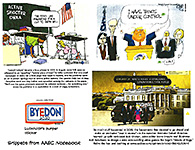
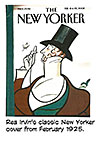


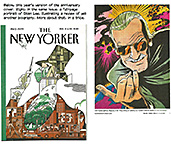
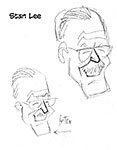


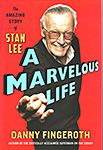
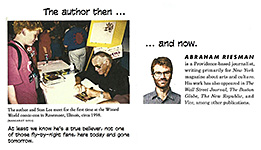
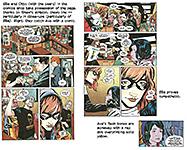
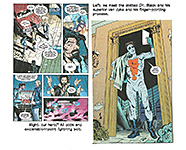
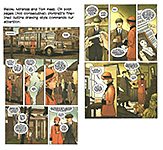
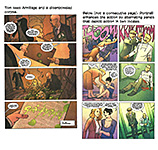

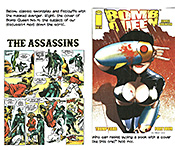
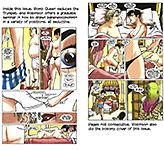
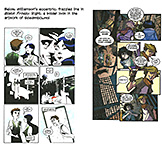

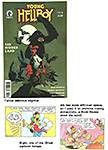
1.jpg)
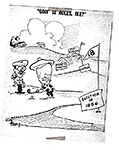
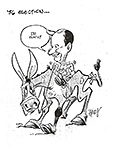

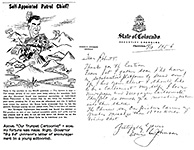
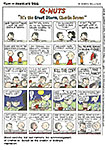

1.jpg)
2.jpg)
1.jpg)
2.jpg)
3.jpg)
